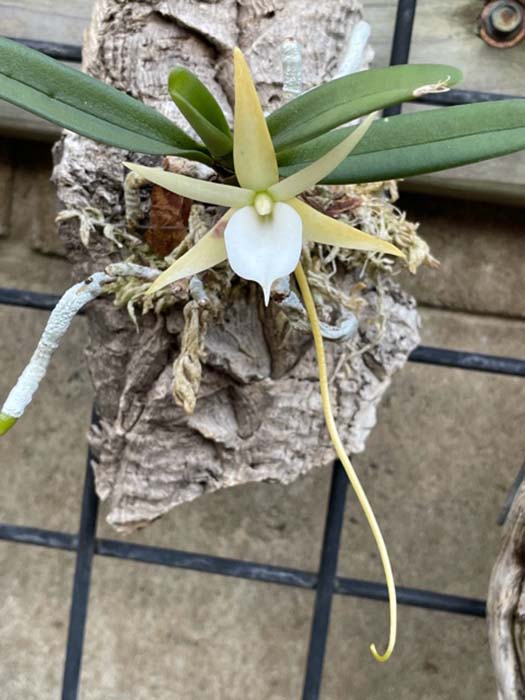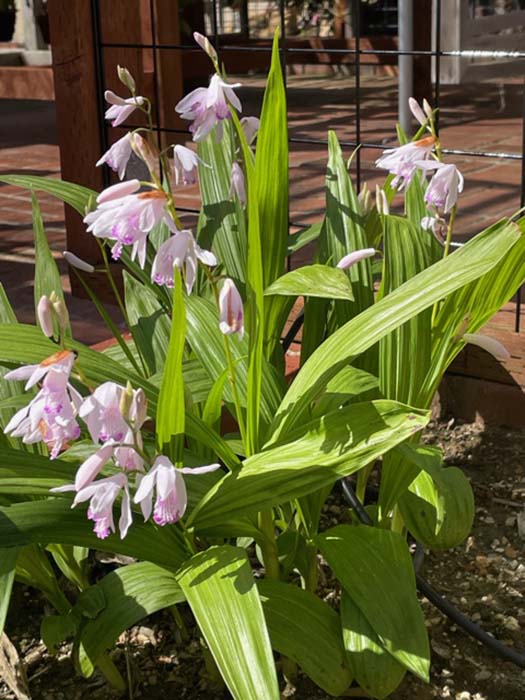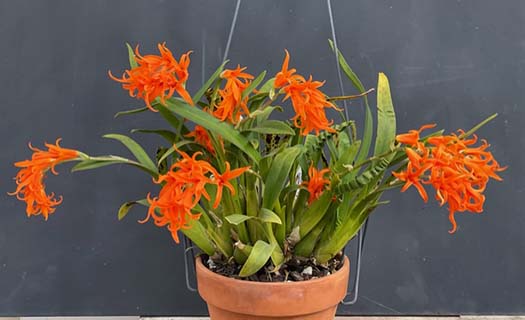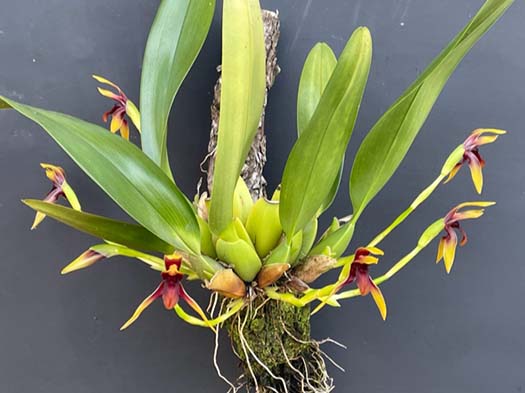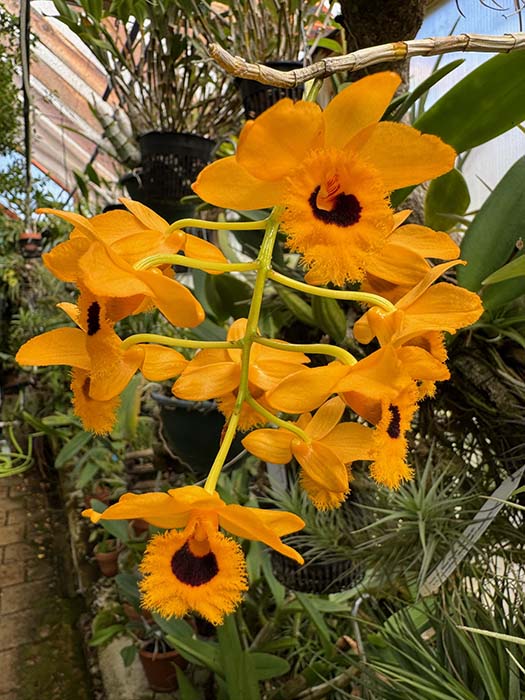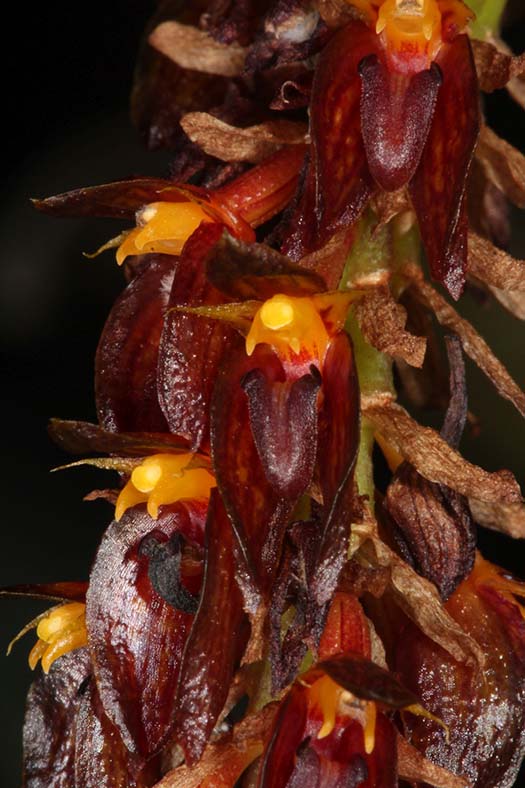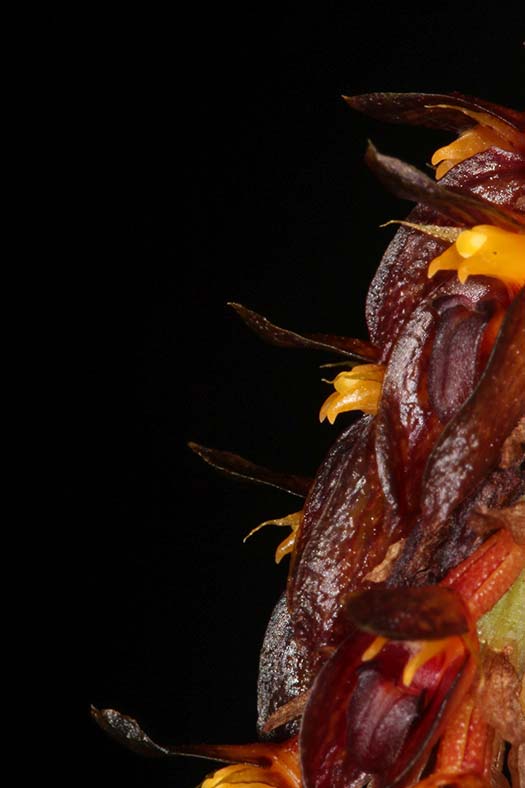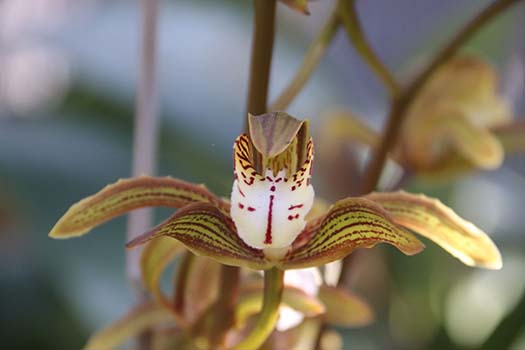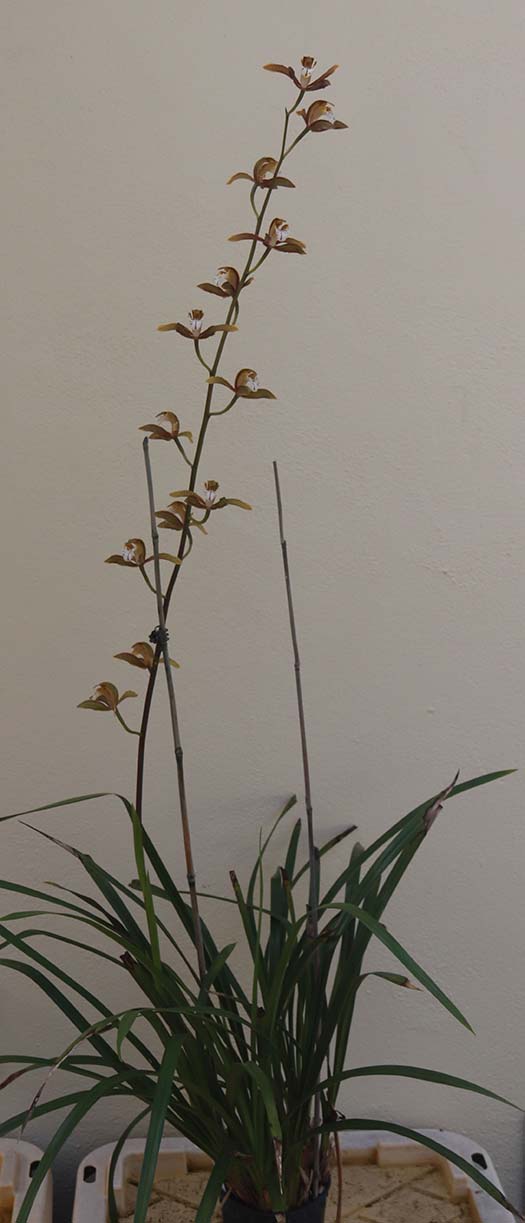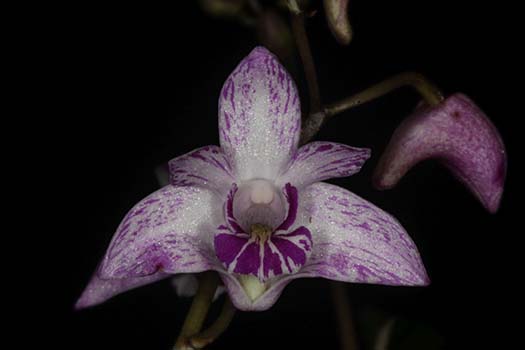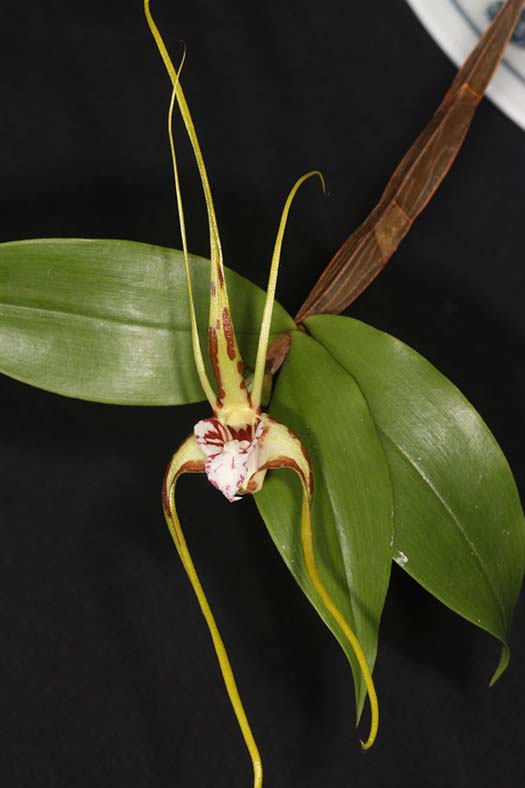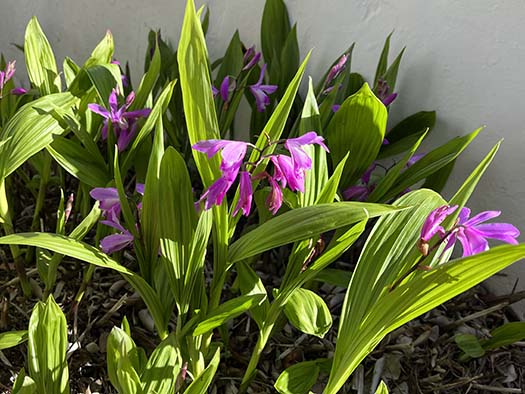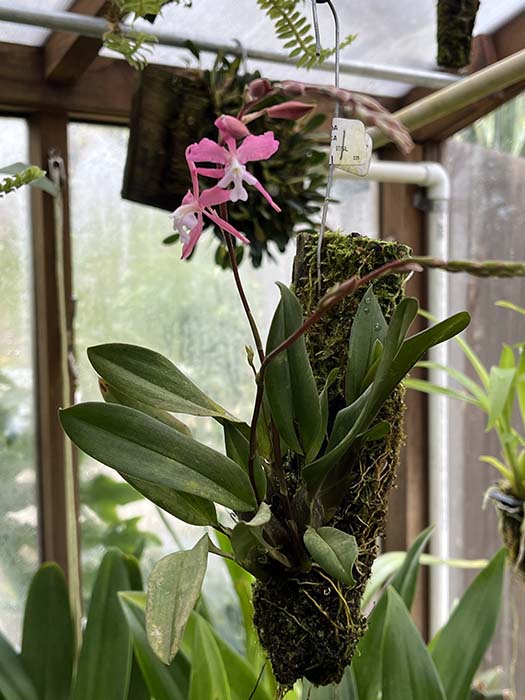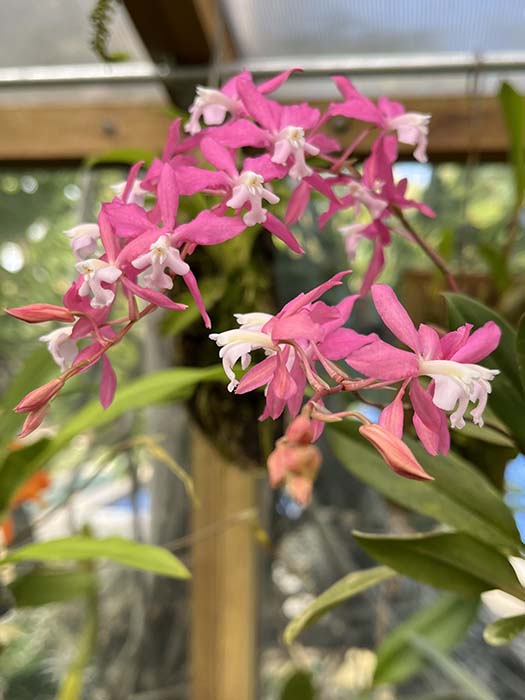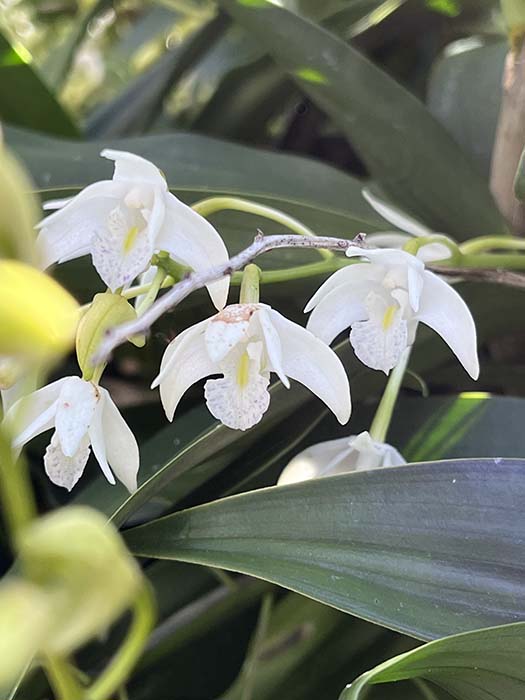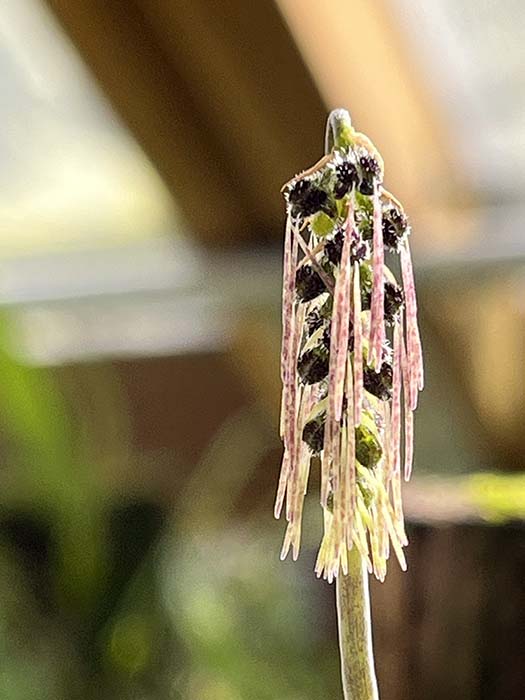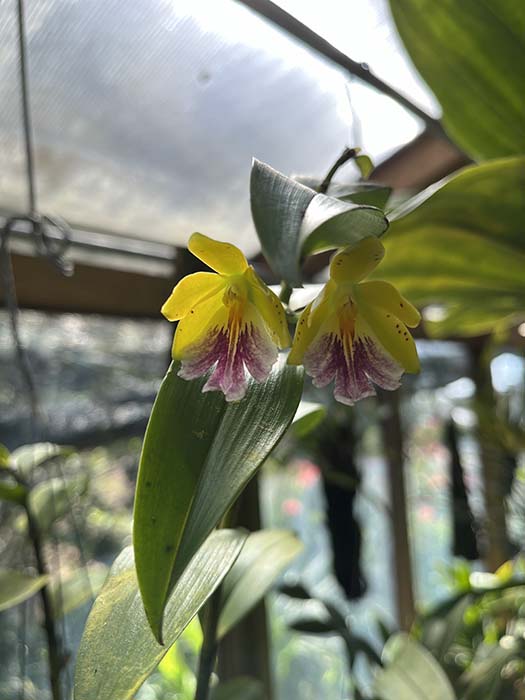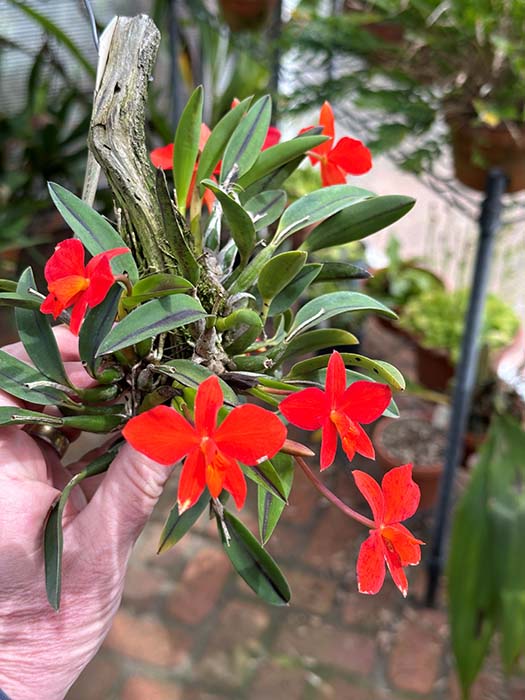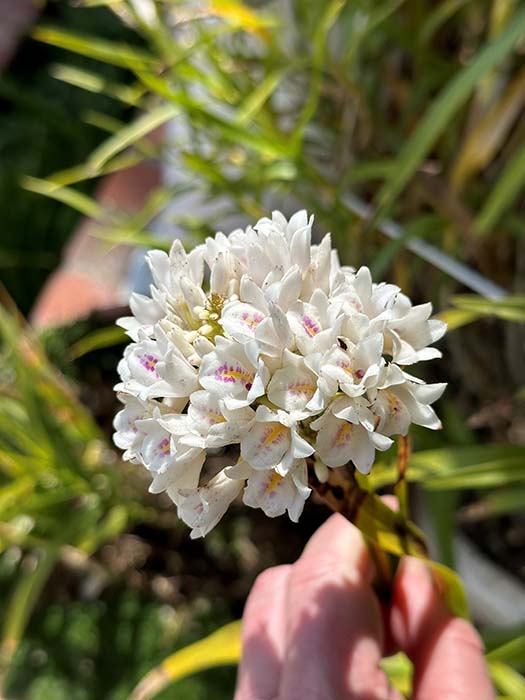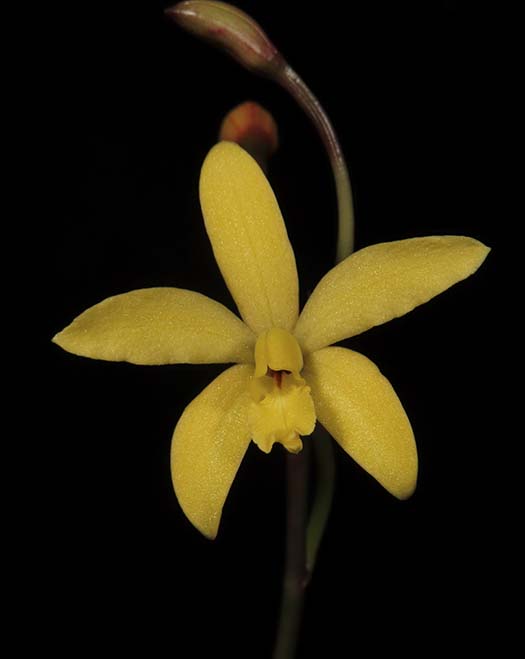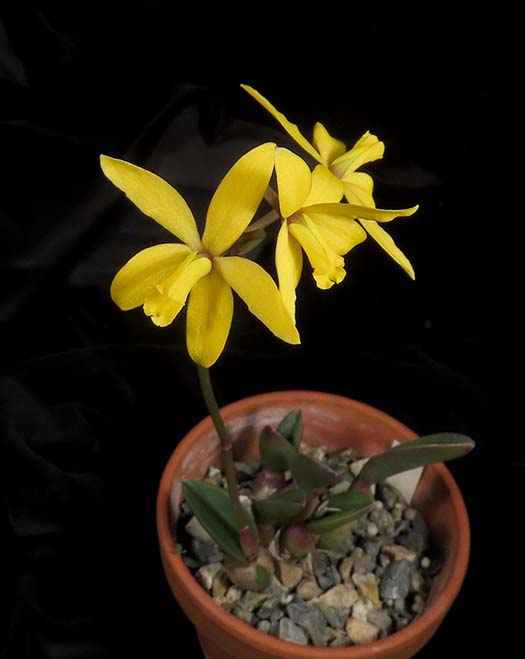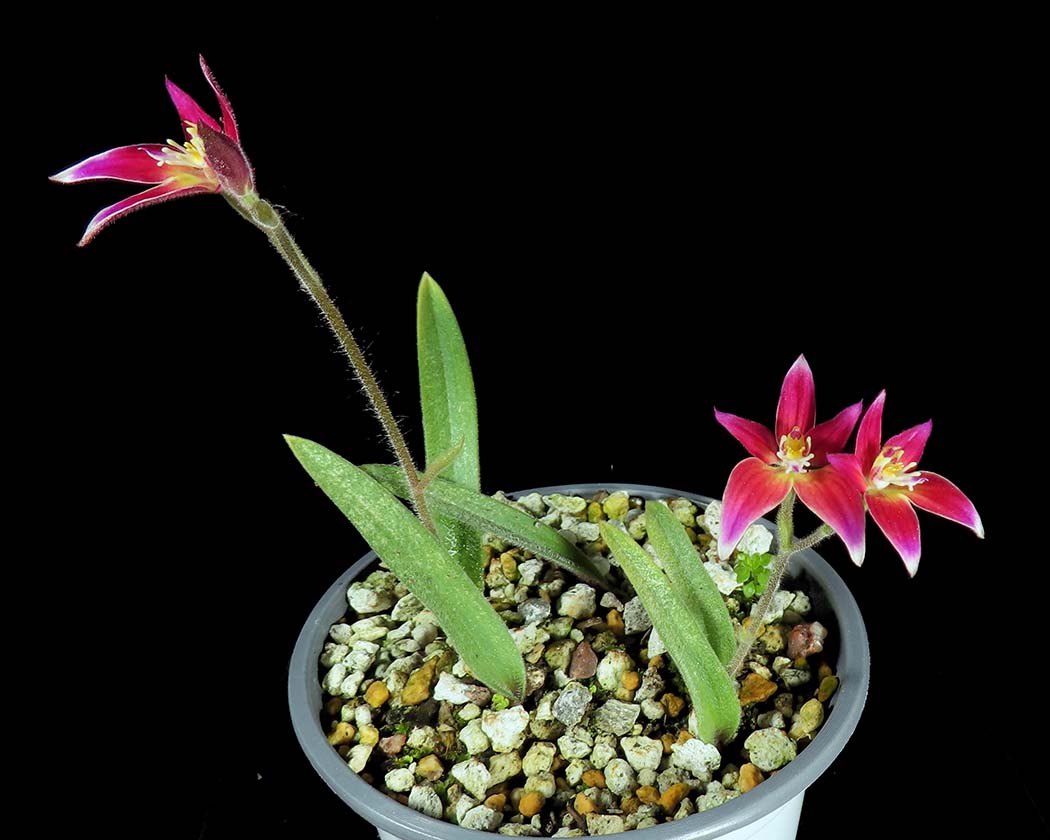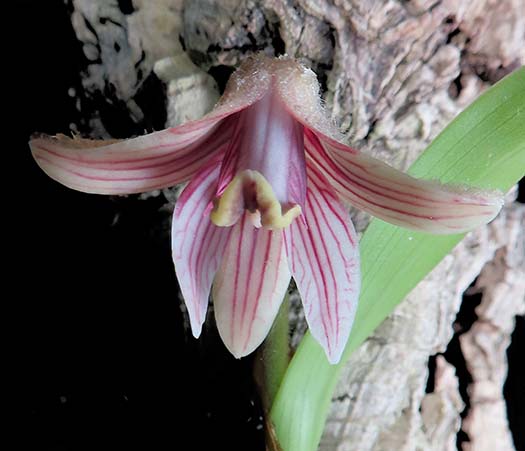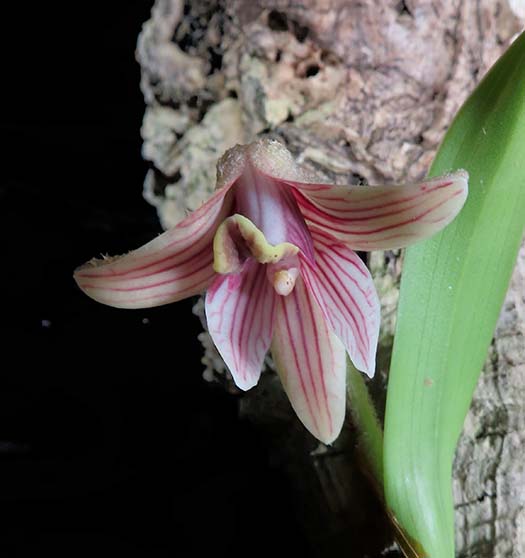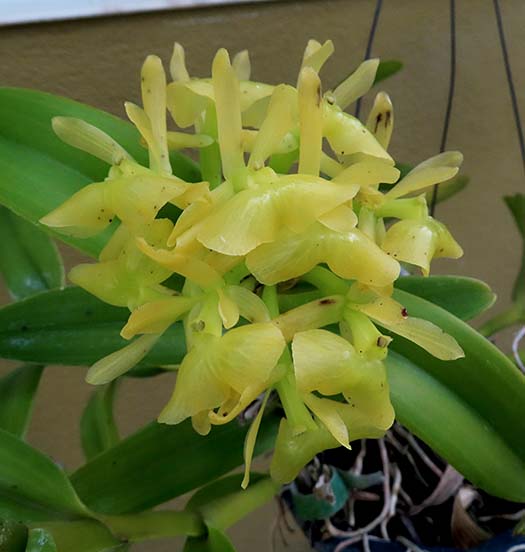April 2024
From Kurt Shanebeck:
|
|
Outdoors coastal, north of Los Angeles: |
|
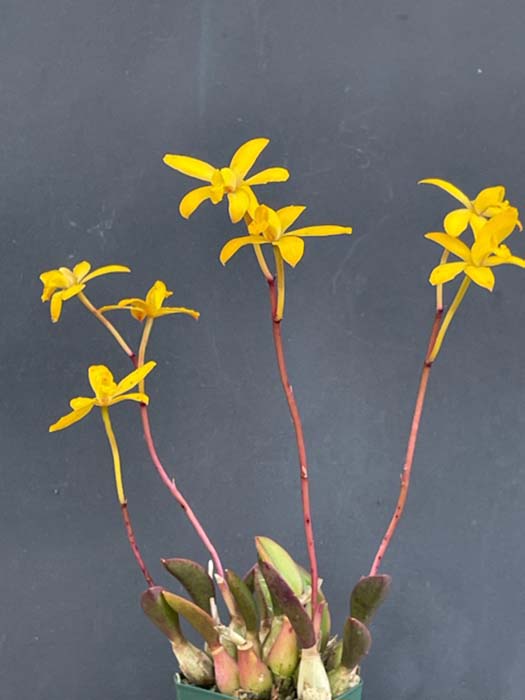
Cattleya itambanaAnother small rupicolous species-similar to endsfeldzii but without red veins on the lip. |

Cattleya walkeriana 'Wilson'An unusual Cattleya in that the inflorescence arises directly from the rhizome rather than from the pseudobulb. Growing potted with bright light. |

Masdevallia nidificaFrom Central and South American cloud forests at elevations of 450-2500m. Growing mounted and shady. |
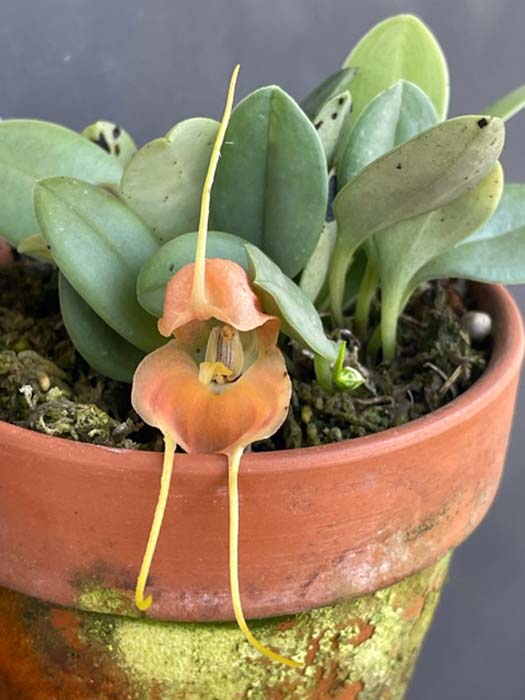
Masdevallia prodigiosaNative to the cloud forests of Peru at elevations around 2000m. Growing potted and shady. |
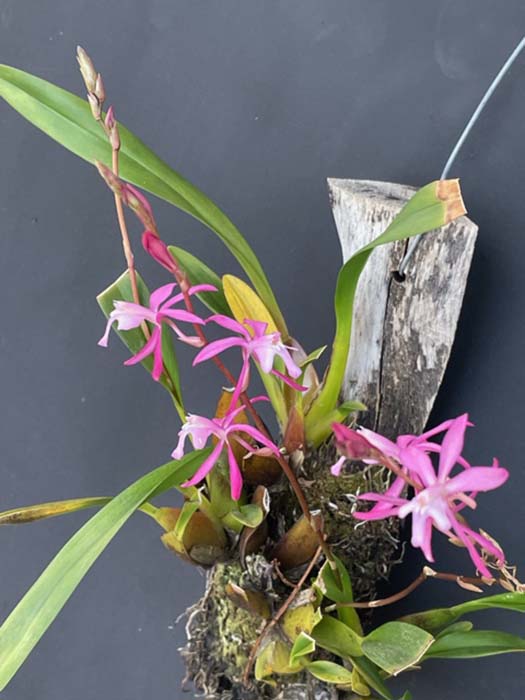
Oncidium vulcanicum
|

Ophrys luteaMediterranean terrestrial species. Growing potted with bright light. |
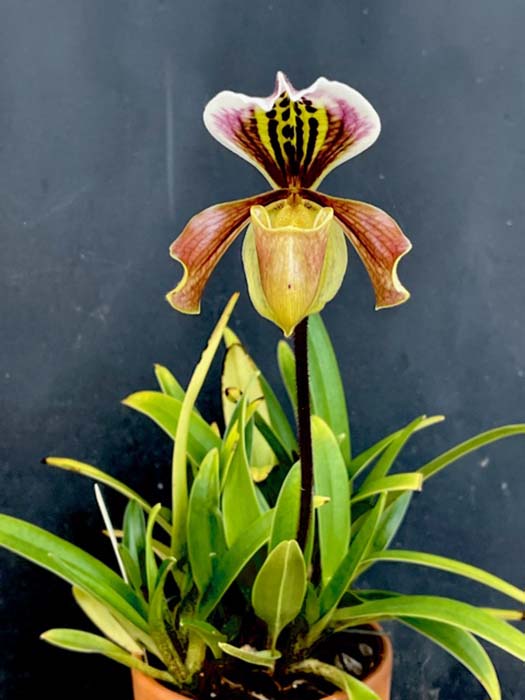
Paphiopedilum gratrixianumNative to China, Laos and Vietnam at elevations of 900-1220m. Growing potted with moderately bright light. |
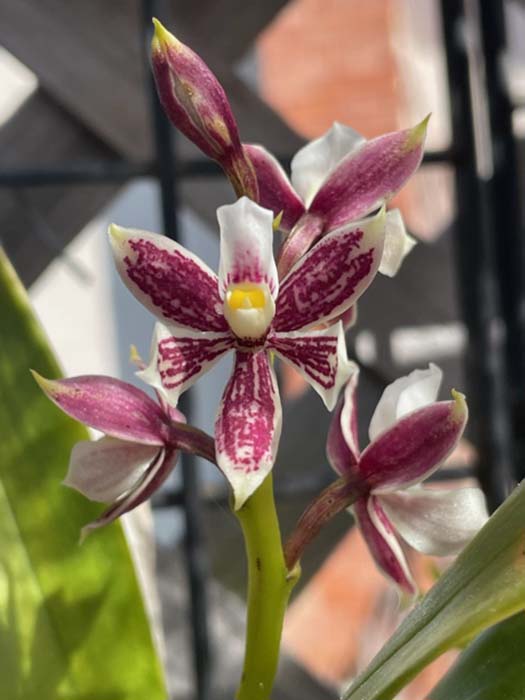
Prosthechea faresianaBrazillian lithophyte found at elevations of 1000-1500m. Growing mounted with bright light. |
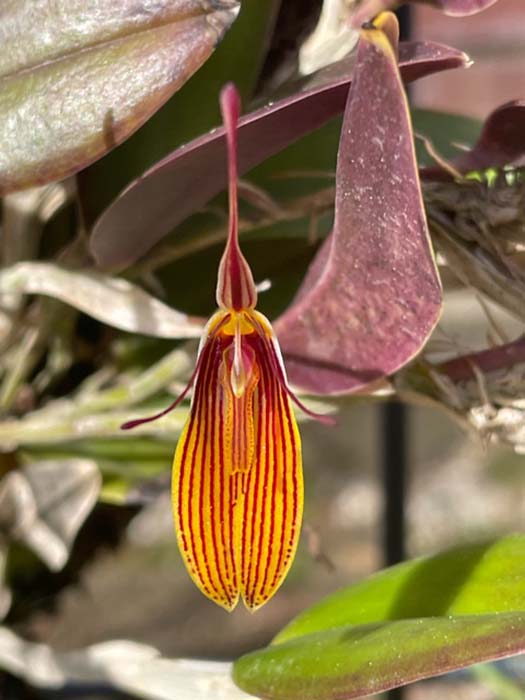
Restrepia brachypusFound in wet South American forests at elevations of 1180-3200m. Growing mounted with moderately bright light. |

Trichoglottis pusilaEpiphyte native to Java and Sumatra at elevations of 1000-2000m. Growing mounted with bright light. |
 |
Trichopilia fragransEpiphyte or terrestrial found from Cuba to Brazil in wet montane forests at elevations of 1200-2800m. Growing potted and shady.
|
Growing indoors under LED light |
|
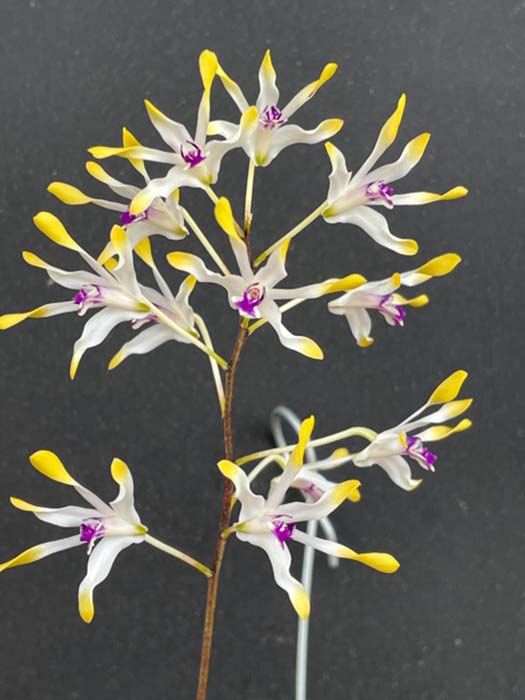 |
Dendrobium canaliculatumEpiphyte from Australia an New Guinea at elevations to 500m. Growing mounted under bright light. |
From Ed Lyszczek:
|
|
Intermediate greenhouse, Templeton, CA (Central Coast) |
|
Dendrobium fimbriatumMy Dendrobiums requiring a dry winter rest are starting to bloom. This D. fimbriatum is mounted on an oak branch with several Tillandsias. It has three spikes developing, this is the first to open. |
|
From Chris Ehrler:
|
|
California Central Coast |
|
Bulbophyllum careyanumA warm to cool growing epiphyte growing in the eastern Himalayas, Assam, Nepal, Bhutan, Sikkim, Myanmar, Thailand, and Vietnam at elevations of 200 to 2,100 meters. This orchid is growing inside a cool greenhouse in a plastic pot filled with sphagnum moss. |
|
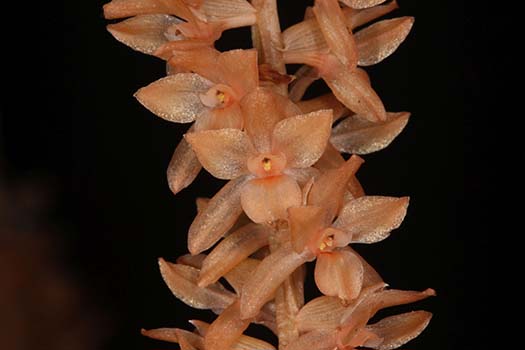 Dendrochilum bicallosumThis species description on orchidspecies.com states the name was changed to D. convallariiforme and that it is a hot to warm growing epiphyte found in the Philippines in shaded areas at elevations of 300 to 900 meters. But this plant is growing well in a cool greenhouse. It is potted in a plastic container filled with Hydroton clay balls. The container has a hole at about 1 inch from the bottom so that there is always some water in the container. |
|

Laelia anceps 'Helen' HCC/AOSThis species grows natively in Mexico and Honduras as a warm to cool growing epiphyte at elevations of 500 to 1,500 meters. Is considered a hardy drought-tolerant species that likes a dry winter rest. This orchid is growing outside mounted to a piece of cork oak with some sphagnum moss at the roots. |

Laelia anceps f. Williamsianum 'Snowdrop'
|
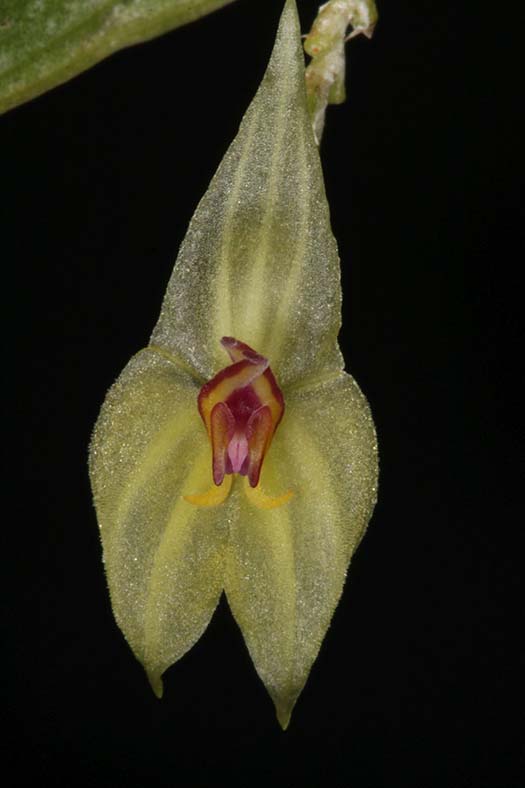 |
 |
Lepanthes nicholasiiA cool to cold growing epiphyte found at elevations around 2,000 meters in Colombia. This orchid is growing in a cool greenhouse mounted on a piece of wood with some sphagnum moss on the roots. |
|
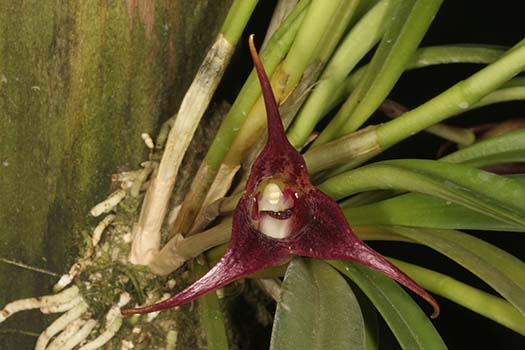
Masdevallia piceaFound in northern Peru and possibly Ecuador growing in cool environment elevations around 2700 meters as an epiphyte. Growing in a cool greenhouse in a clay pot filled with a mixture of bark and lava rock. |
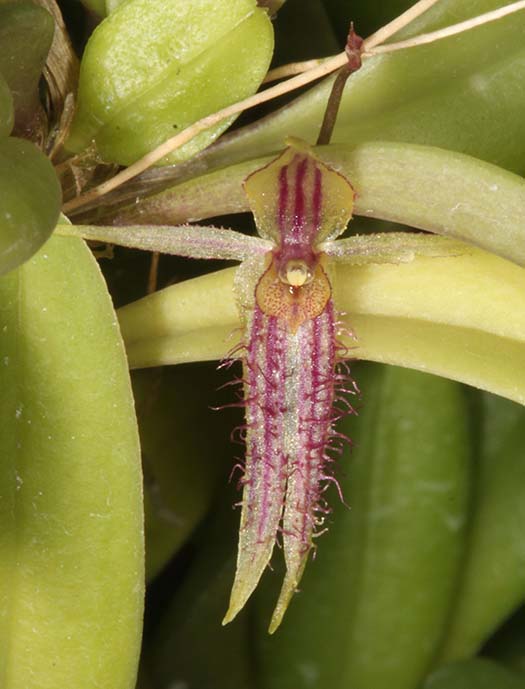
Pleurothallis schizopogonA cold growing epiphytic species found in southern Ecuador and northern Peru at elevations of 2,400 to 3,100 meters. Growing in a cool greenhouse mounted on a piece of wood with some sphagnum moss on the roots. |
 |
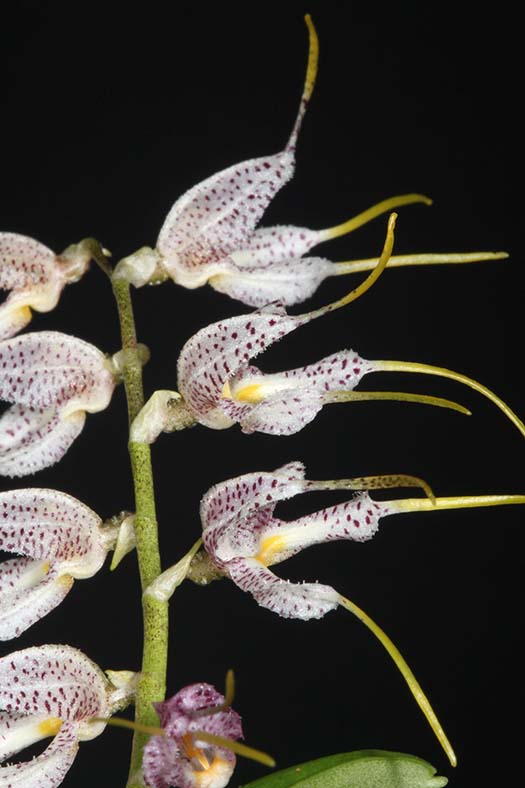 |
Masdevallia polystictaA cool to cold growing orchid found at elevations of 1600 to 3000 meters in Ecuador and Peru. Growing in a cool greenhouse mounted on a piece of cork oak with some sphagnum moss on the roots. |
|
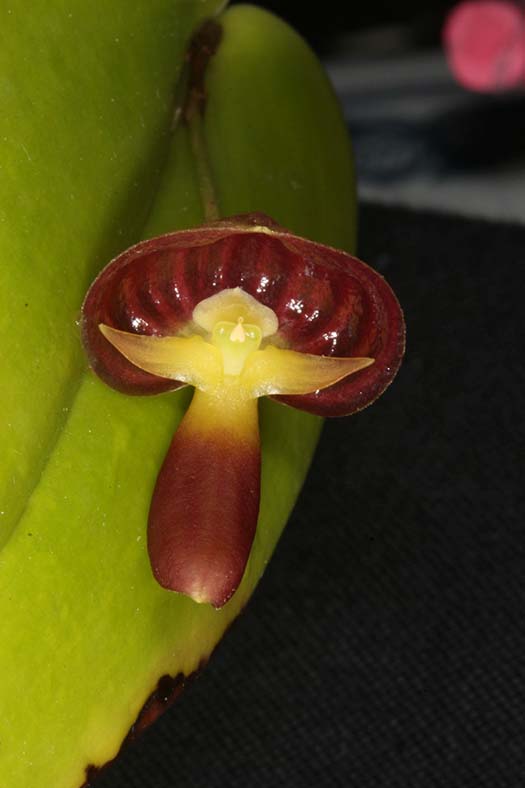 |
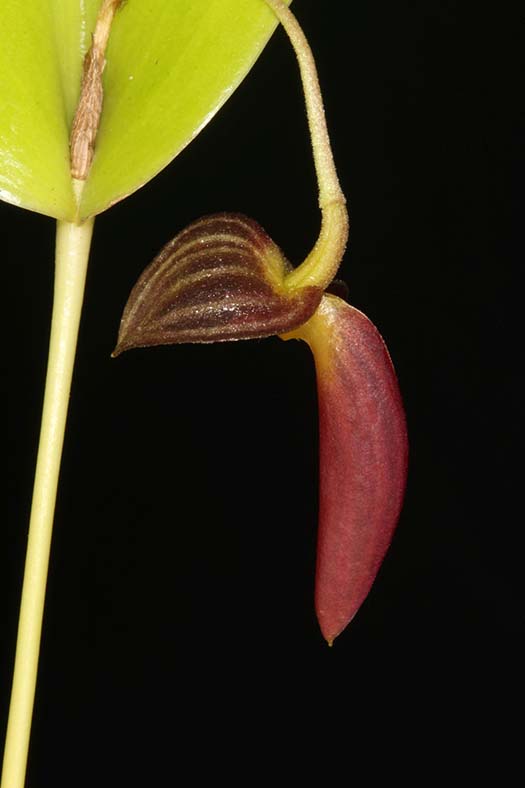 |
Pleurothallis adelaeIs a warm to cool growing terrestrial species found in Ecuador and Bolivia at elevations of 1450 to 2250 meters. This orchid is growing in a clay pot filled with sphagnum moss that is placed in a cool greenhouse. |
|
 |
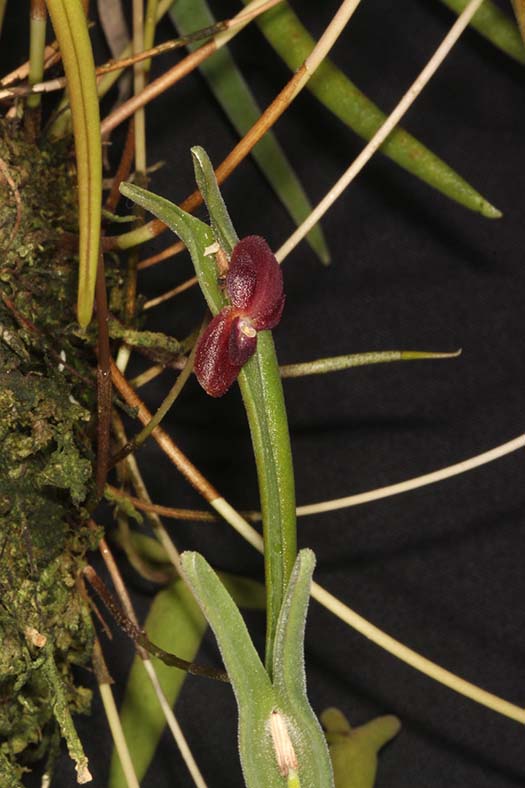 |
Pleurothallis dilemmaA cool to cold growing epiphyte species growing Colombia Ecuador at elevations of 1,800 to 2,900 meters. Growing in a cool greenhouse mounted on a piece of wood with some sphagnum moss on the roots. |
|
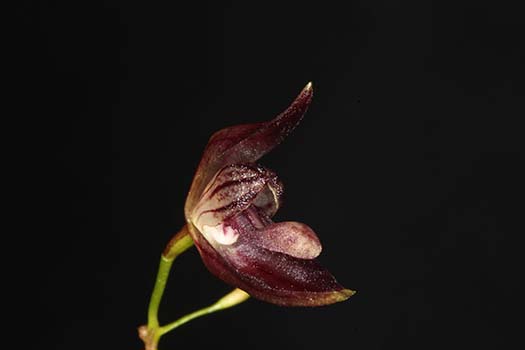 |
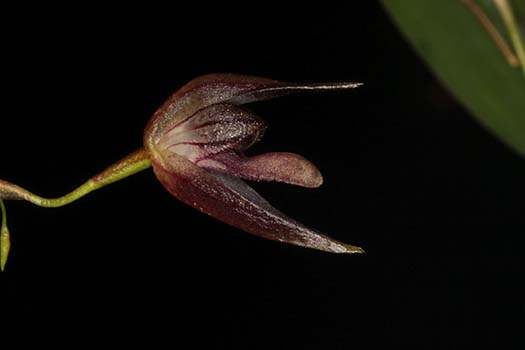 |
Pleurothallis pachyglossaGrows as a cool to warm epiphyte in Mexico, Guatemala, Honduras and Costa Rica at elevations of 500 to 1,700 meters. This plant was purchased many years ago off the $7.50 table at Santa Barbara Orchid Estate. Grown outside under wood lath on the north side of the house. Growing mounted to a piece of cork oak with sphagnum moss on the roots. |
|
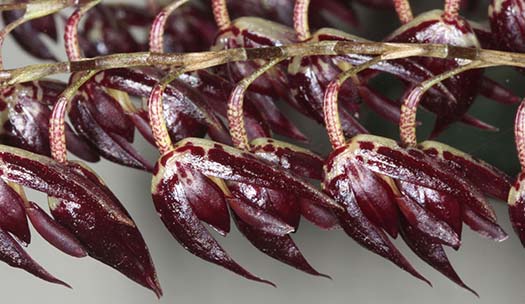
Pleurothallis restrepioidesGrowing outside in a plastic pot filled with sphagnum moss. Growing outside under a lath shade structure. |
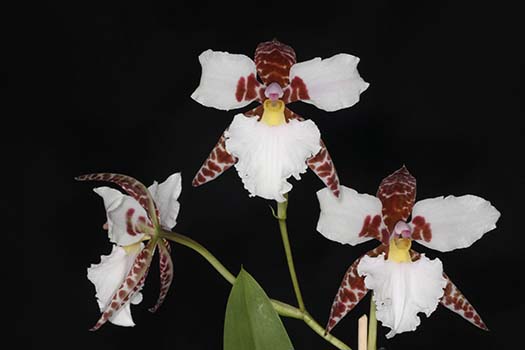
Rhynchostele (formerly Lemboglossum) rossiiFound in Nicaraguan, Honduran, Salvadorean, Guatemalan and Mexican growing as a cold to cool growing epiphytic at elevations of 2000-3000 meters. Growing both in a cool greenhouse in a clay pot filled with sphagnum moss and outside on the north side of the house in a plastic pot filled with bark and lava rock. |
 |
 |
Restrepia contortaFound in Venezuela, Colombia, Peru, and Ecuador growing as a cool to warm epiphytic species in cloud forests at elevations around 1,300 to 3,200 meters. Growing in a cool greenhouse mounted on a piece of wood with some sphagnum moss on the roots. |
|
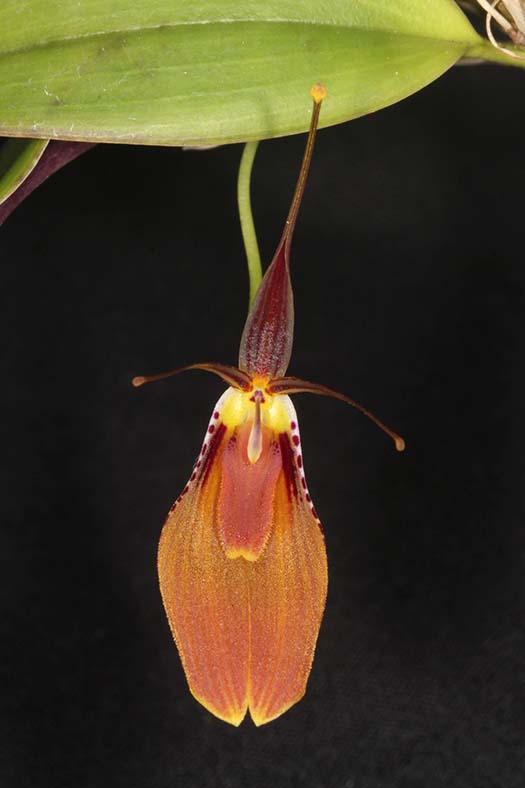 |
 |
Restrepia cupreaA warm to cool growing epiphyte found on Colombia’s eastern slopes of the central cordillera at elevations of 1,600 to 1,700 meters. This orchid is growing in a clay pot that is filled with sphagnum moss. Grown in a cool greenhouse. |
|
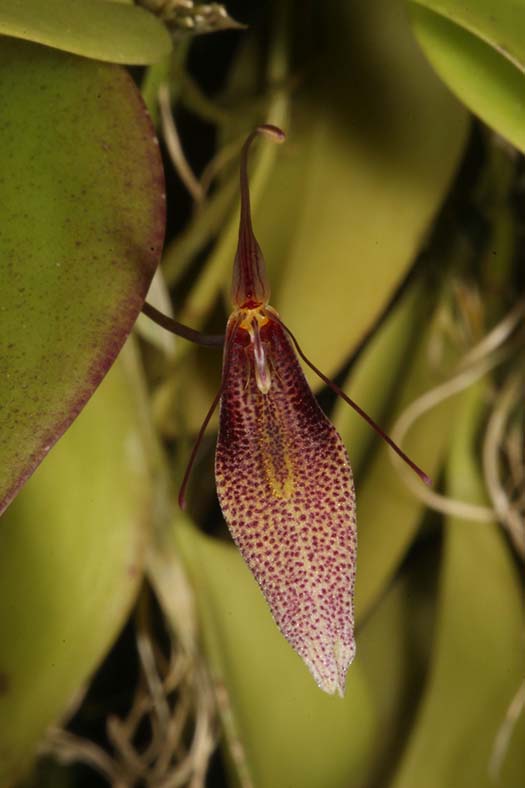 |
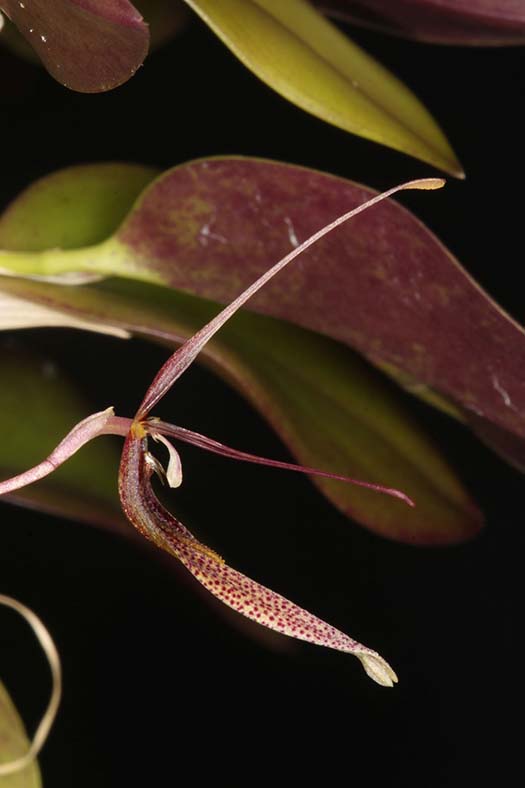 |
Restrepia dodsoniiA cool growing epiphyte found in Ecuador at elevations between 1,060 to 1,700 meters. Growing in a cool greenhouse in a clay pot filled with sphagnum moss. |
|
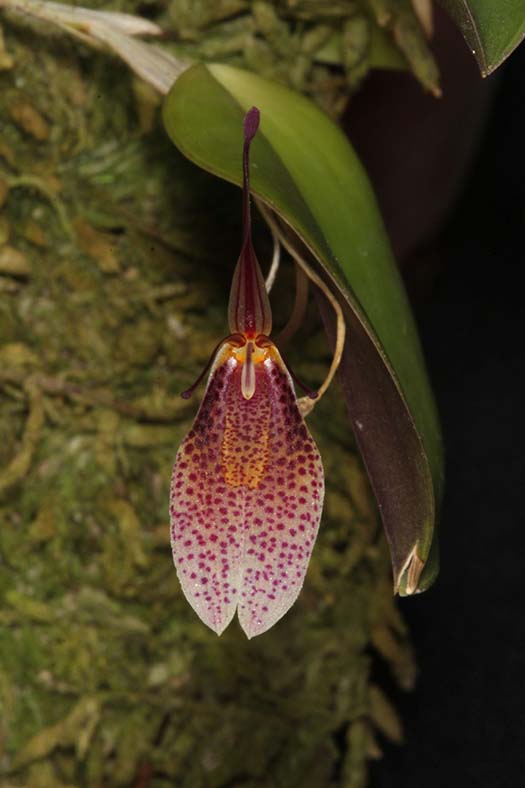 |
 |
Restrepia landsbergiiFound at elevations of 700 to 3,000 meters in Venezuela, Ecuador, and Peru growing as a cool to cold growing epiphyte. Growing in a cool greenhouse mounted on a piece of wood with some sphagnum moss on the roots. |
|
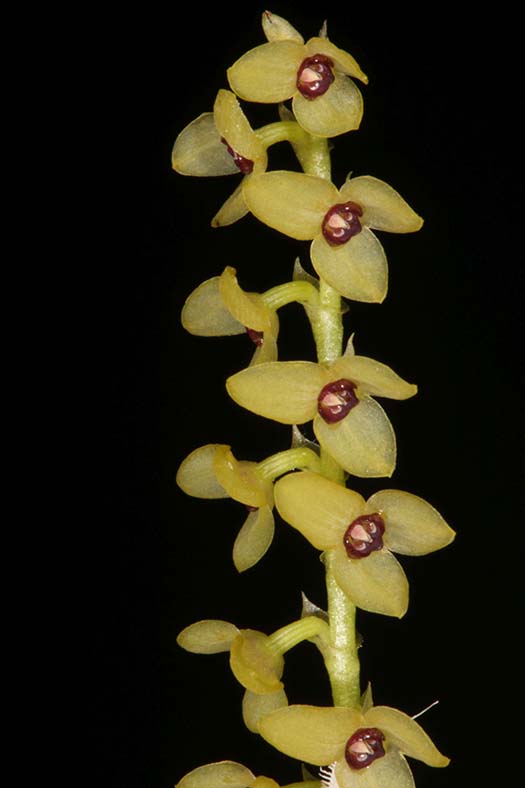 |
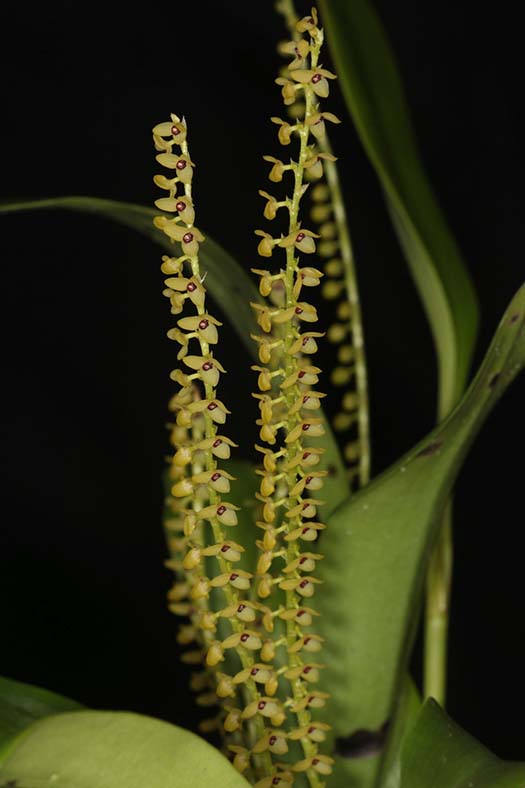 |
Stelis striolataA cool to cold growing epiphyte or terrestrial growing at elevations of 2,000 to 3,000 meters in Venezuela, Colombia, Ecuador, and Peru. This orchid is growing in a clay pot filled with sphagnum moss that is placed in a cool greenhouse. |
|
From Arnold Markman:
|
|
Intermediate Greenhouse, coastal San Diego area
|
|
Bletilla striataI have had a large clump of these growing outside for years. They are semi shaded and get watered about every four days. I live within a few blocks of the ocean so the climate is pretty moderate. |
|
Cochlioda vulcanica (Oncidium vulcanicum)This is a small mounted grower from Ecuador. |
|
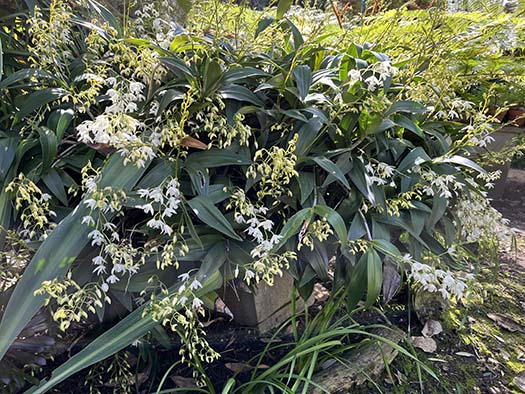 Dendrobium kingianum (white)Grown outside in coastal Encinitas watered every fourth day. |
|
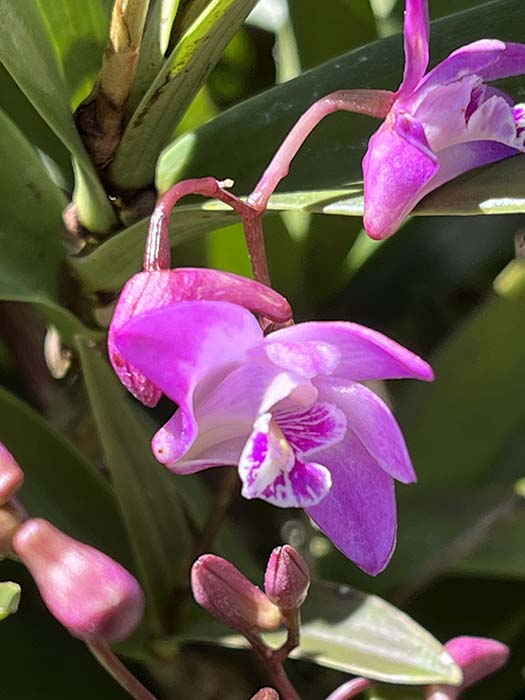
Dendrobium kingianum (pink)Grown outdoors in coastal Encinitas. Upper right, is plant in pot grown in probably 70% sun. Lower right, is a keiki that fell off and is growing on a log under avocado tree. (Avocado is mostly leafless this time of year) Watering is every 4-5 days |
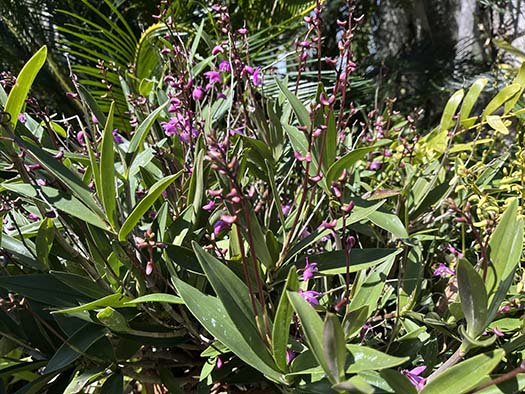 |
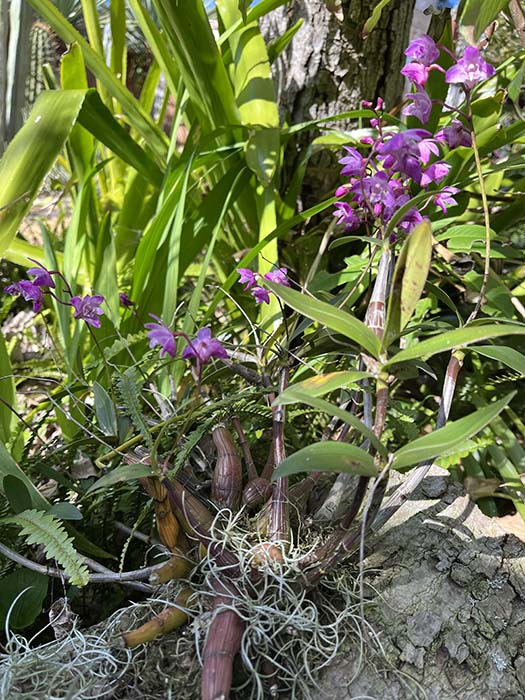 |
|
 |
|
Bulbophyllum lemniscatoidesIt was watered every day until the leaves fell off and then I stopped watering it. I still haven’t resumed watering it, but mist it daily. |
|
 Vanda cristata |
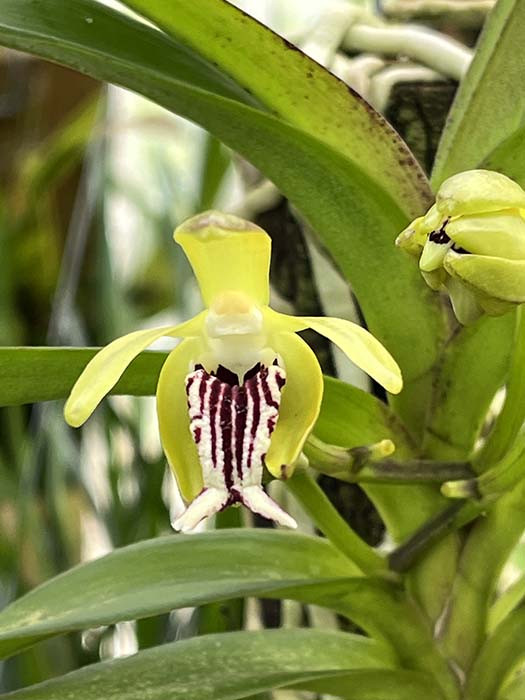 |
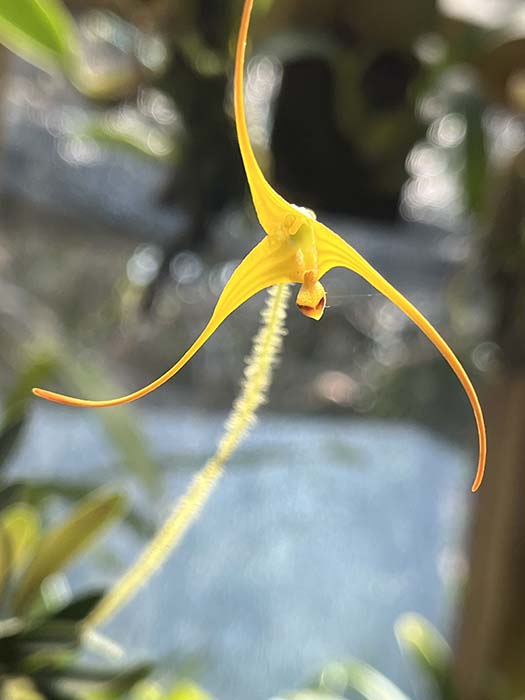 |
|
Porroglossum muscosum |
|
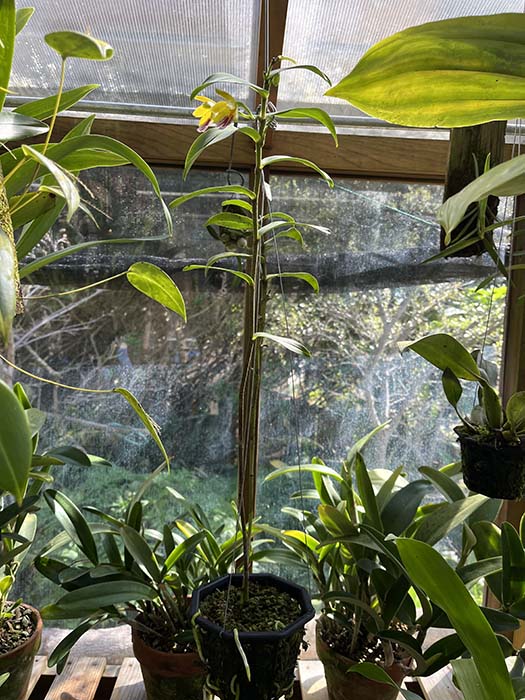 |
|
Epidendrum wallisii (Oerstedella wallisii) |
|
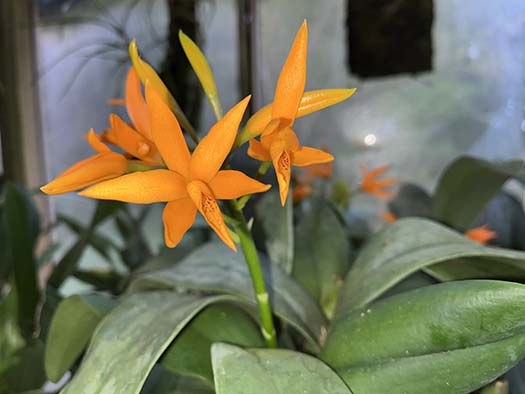 |
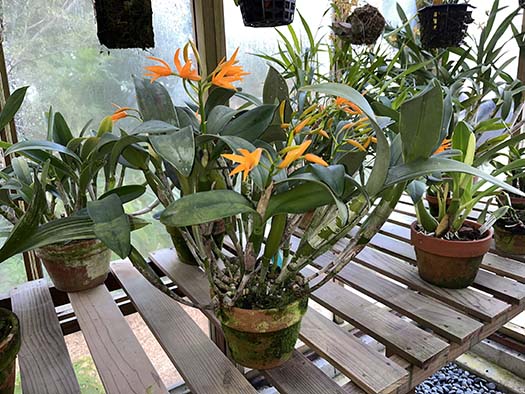 |
Cattleya (Guarianthe) aurantiacaWatered once per week |
|
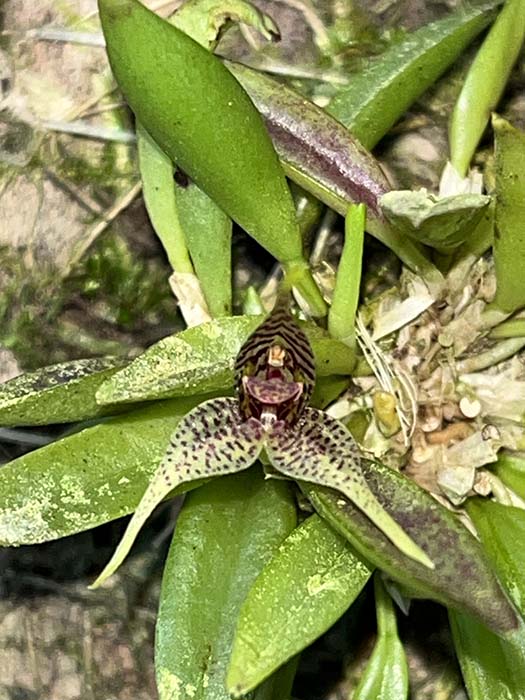 |
 |
Dryadella zebrina |
|
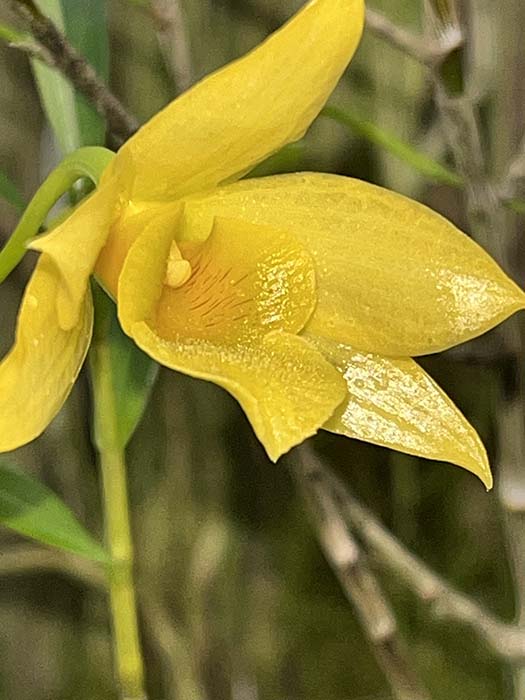 |
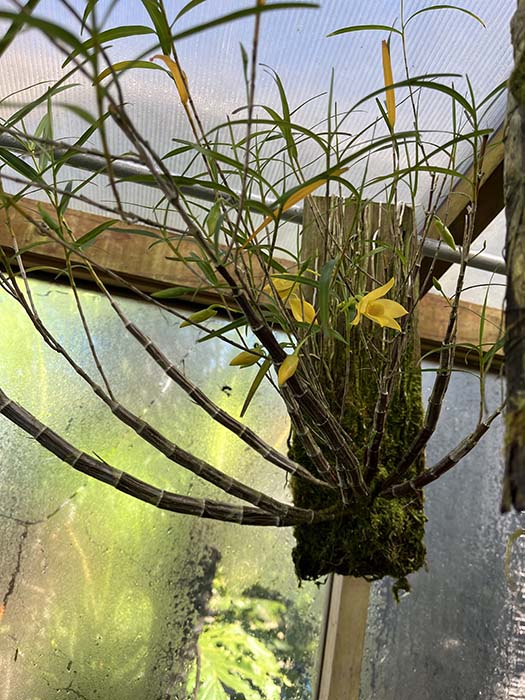 |
Dendrobium hancockiiIt is at the warmer sunnier end of the greenhouse. I water this daily year round. |
|
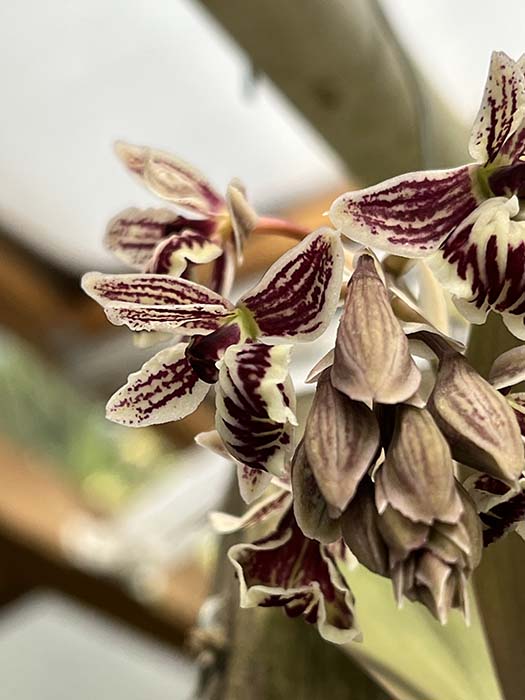 |
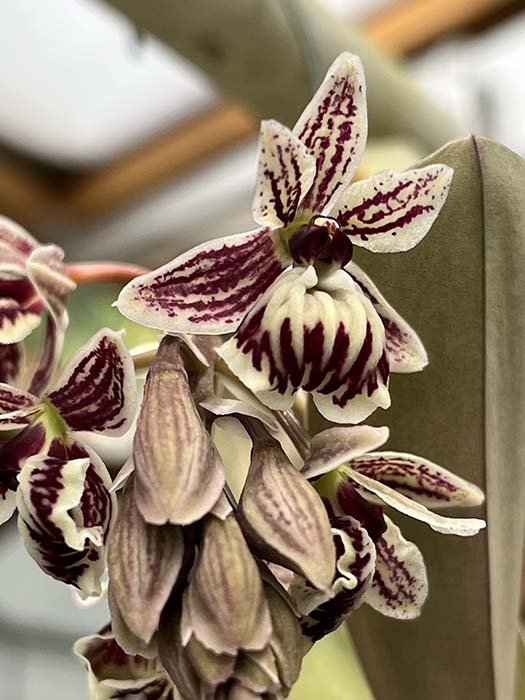 |
Epidendrum marmoratumWater daily in summer and every other day during fall and winter. |
|
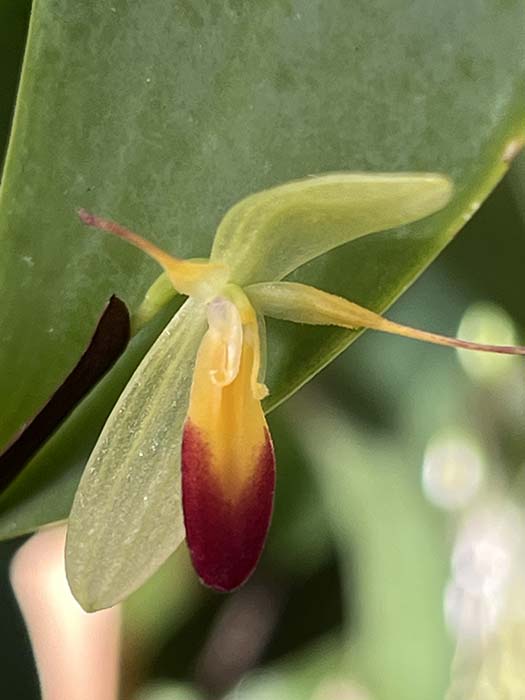
Pleurothallis medinaeMisted multiple times per day in addition to daily watering |
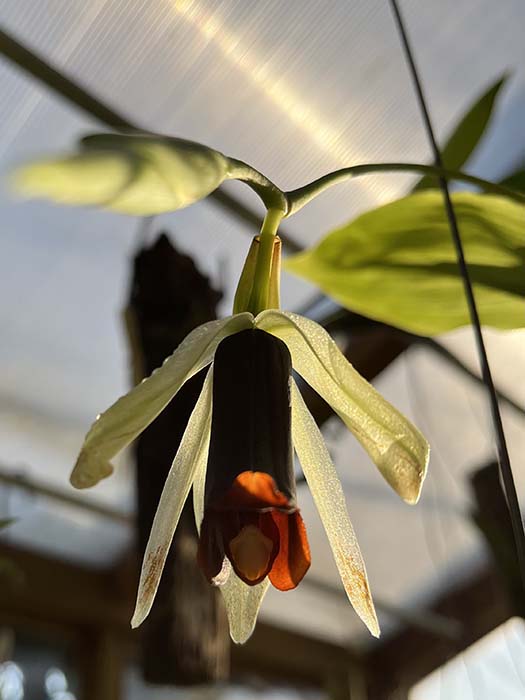
Coelogyne usitanaI’m growing it in the warmer western end of the greenhouse. Temperature in the winter has gone down as low as 47°. |
From Scott McGregor:All orchids grown outdoors, coastal southern California |
|
Dendrochilum tenellumHundreds of spikes and thousands of tiny flowers—imagine the AOS judge who gets to count ‘em! |
|
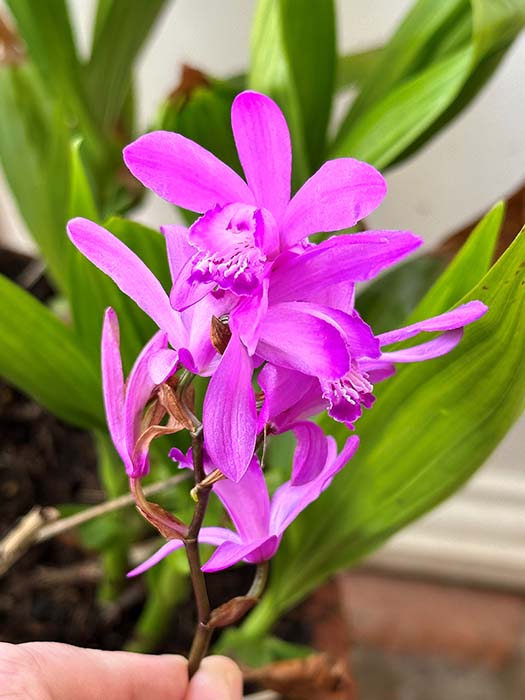 |
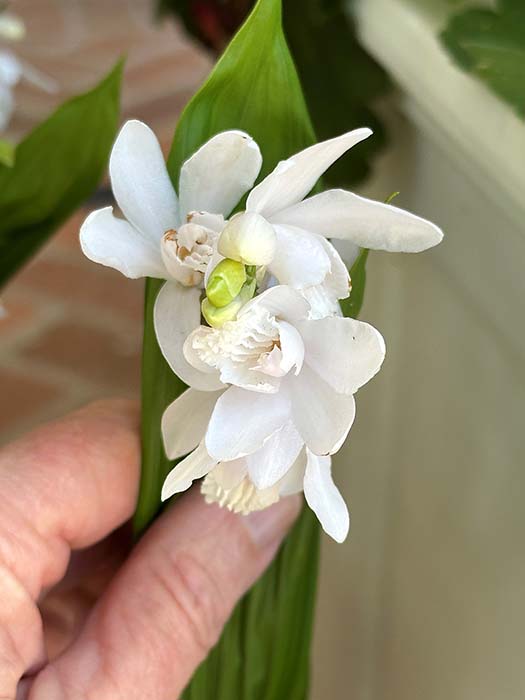 |
Bletilla striataB. striata is a lovely spring-blooming terrestrial that you can plant directly in your garden or in large pots. It likes at least a couple hours of full sun. It has both colorful as well as alba forms. The colorful one is Bletilla striata 'Big Bob' The weather-spotted alba form is Bletilla striata 'White Pearl' |
|
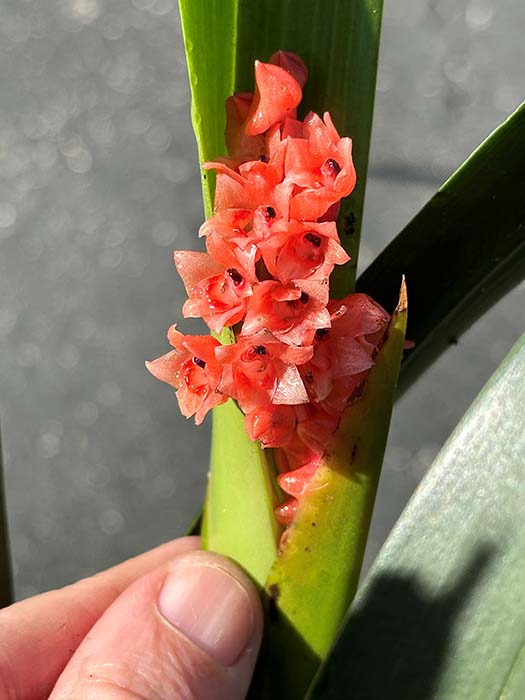
Epiblastus basilisDefinitely an odd species that extends upward with each new pseudobulb and has flowers suddenly bursting from within the nodes. Easy outdoor grower—likes cold and wet winters. |
|
Neobenthamia gracilisOn the patio in full sun, this plant is now a 3’ diameter bush that is everblooming, with the heaviest bloom mid-summer. This pom has been open for a month and while a bit weather-spotted, is still fragrant and cheerful. |
|
From Roberta Fox:Coastal southern California |
|
Outside in the Back Yard: |
|
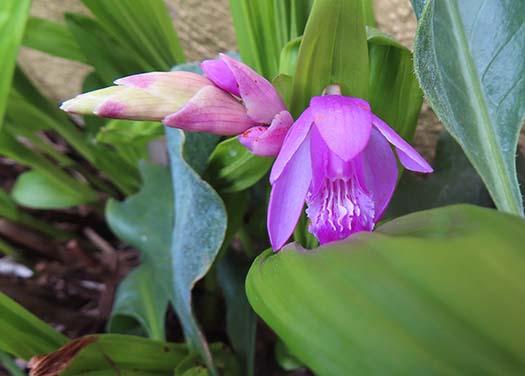
Bletilla striataIt is spring! This clump that I planted in the ground (horrid clay soil) grows better than any that I have in pots. |
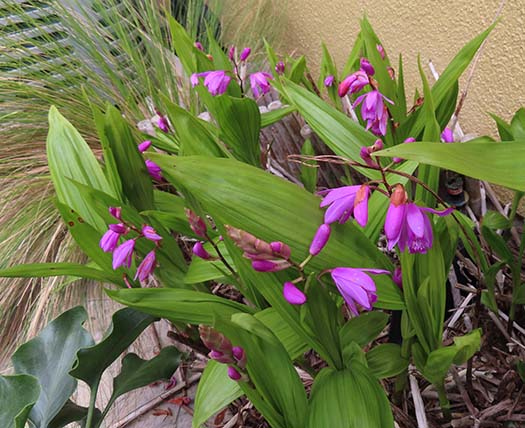 |
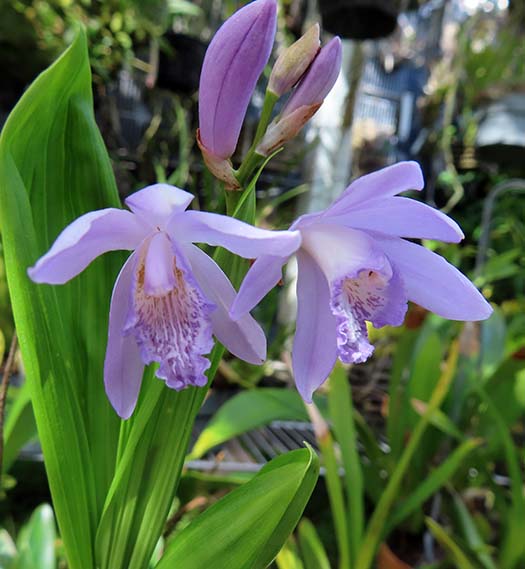 |
Bletilla striata f. coerulaA somewhat unusual color form. |
Cattleya sp. (Rupiculous Laelia sp.)An undescribed species. Flowers bigger than the plant. Growths are short and succulent. |
|
|
|
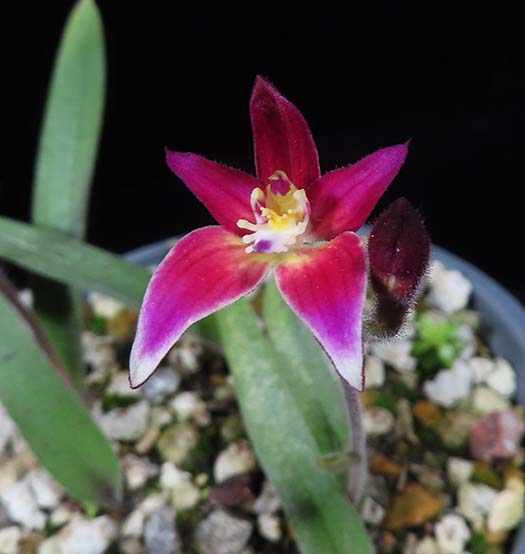
Caladenia HarlequinA primary hybrid, Calda. flava x Calda. latifolia. I exercise editorial prlvilege here... normally hybrids (other than natural ones) are off limits. But Caladenia is tricky to grow (small root system, small tuber, one leaf per growth) and at least so far, it's the only way that I can show you this beautiful Austrialian terrestrial genus. I do have Calda. latifolia growing for me, I had hoped for flowers ... nice strong leaves, good chance for tubers, so maybe next year I'll have a species to show. |
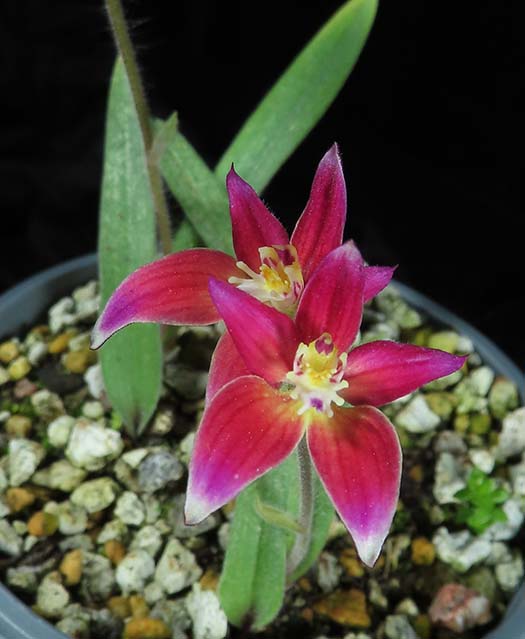 |
Campanulorchis globiferaNative to Vietnam, 800-2200 m. Genus Closely related to Eria. The backs of the sepals are wooly. (I do love fuzzy orchids). This tends to be a rambler. |
|
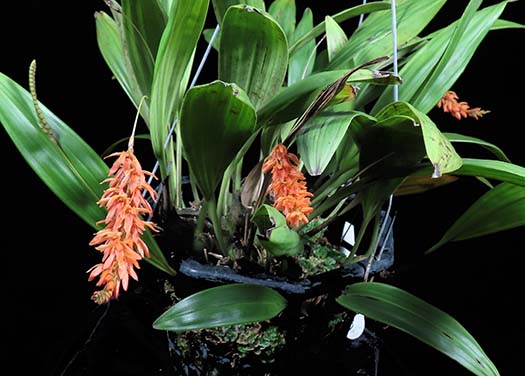
Dendrochilum coccineumNative to Mindinao, Philippines around 1000 m. It doesn't open all of its spikes at once, the bloom period lasts around 2 months. Flowers are relatively large for the genus. |
 |
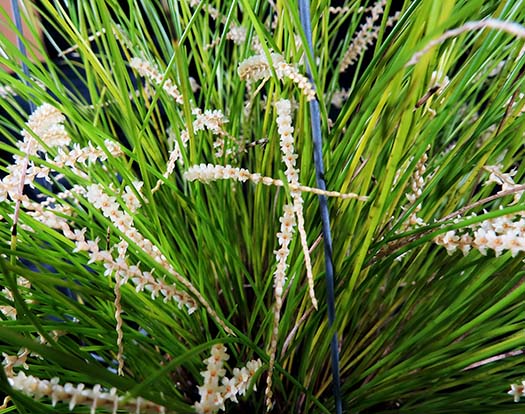
Dendrochilum tenellumYou see Scott's magnificant plant above. Here's what the teensy flowers look like up close. |
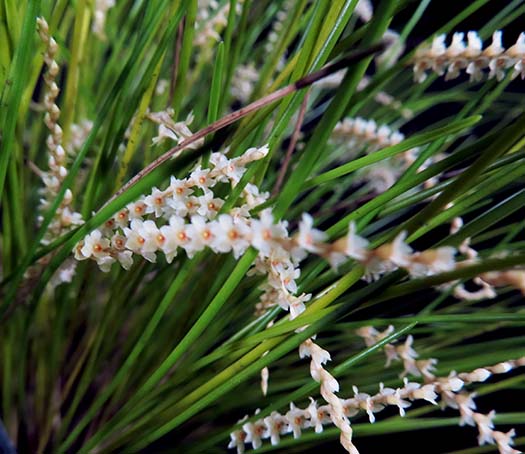 |
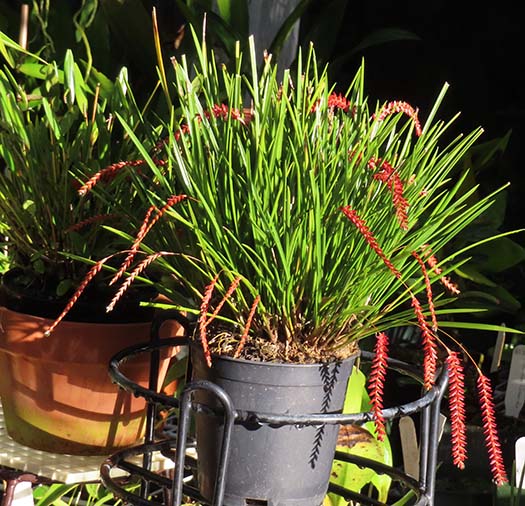
Dendrochilum wenzeliiThis is one of the best bloomings that I have seen on my plant. The flowers almost glow in the early morning sunlight. It's getting quite crowded in the pot, perhaps that is what it was waiting for. |
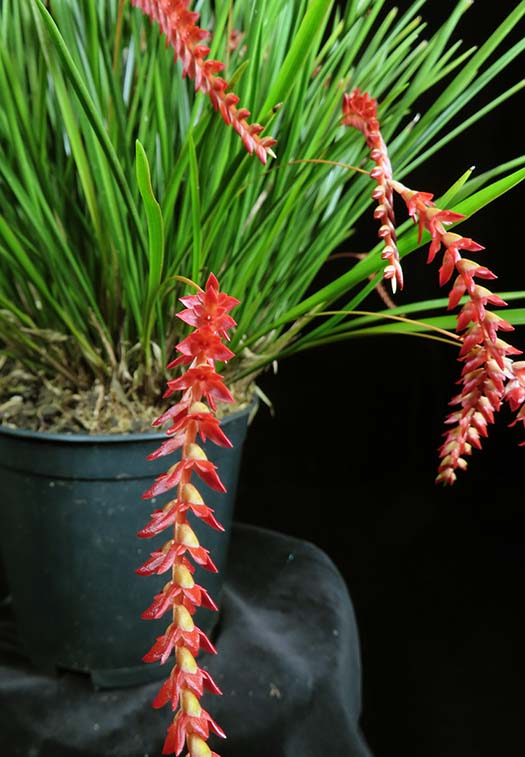 |
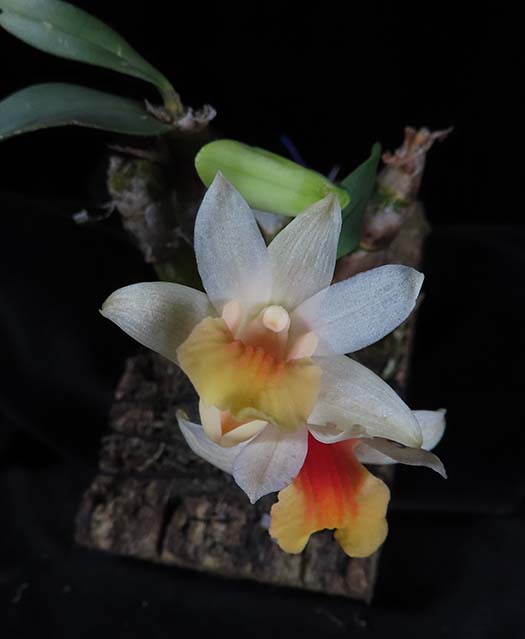 Dendrobium bellatulumA charming miniature. The orange in the thoat becomes darker as the flower ages. It is semi-deciduous, but I don't dry it out in winter. Being mounted it dries fast after watering. It does get cold and that seems to be a sufficient trigger for early spring blooming. |
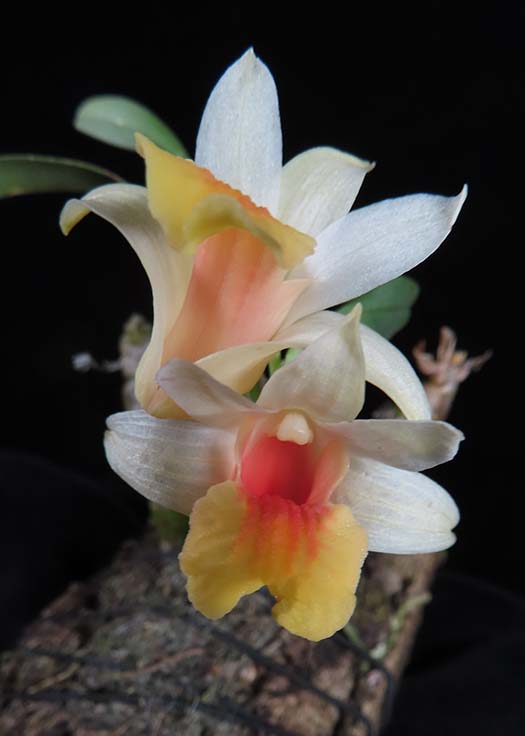 |
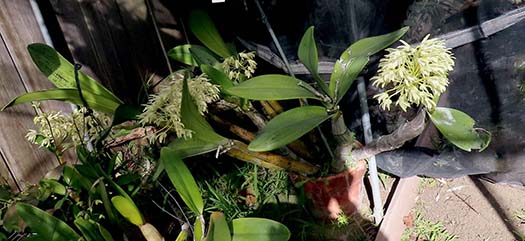
Dendrobium speciosum var. grandiflorumOverall, this year was pretty much a bust for most of my Den. speciosums. (The speciosum hybrids are getting ready to bloom, but nearly a month later than usual.) Last year was spectacular, maybe they needed a break. This plant did put on fairly decent show, though. |
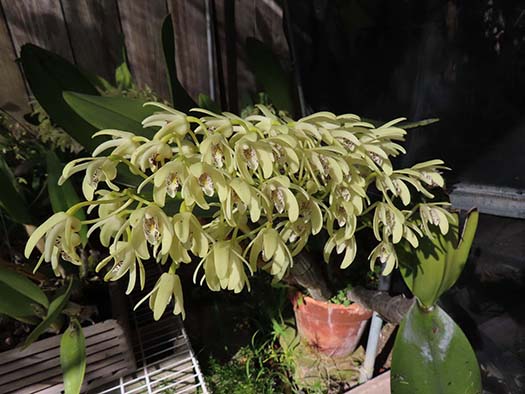 |
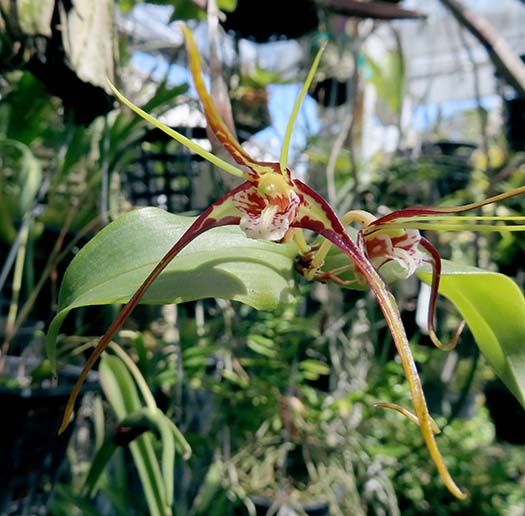
Dendrobium tetragonumMore flowers than usual simultaneously, and the canes produce more sequentially. The canes (with their 4-sided cross-section that is reflected in the name) are somewhat pendant, so it is best grown mounted or in a basket.
|
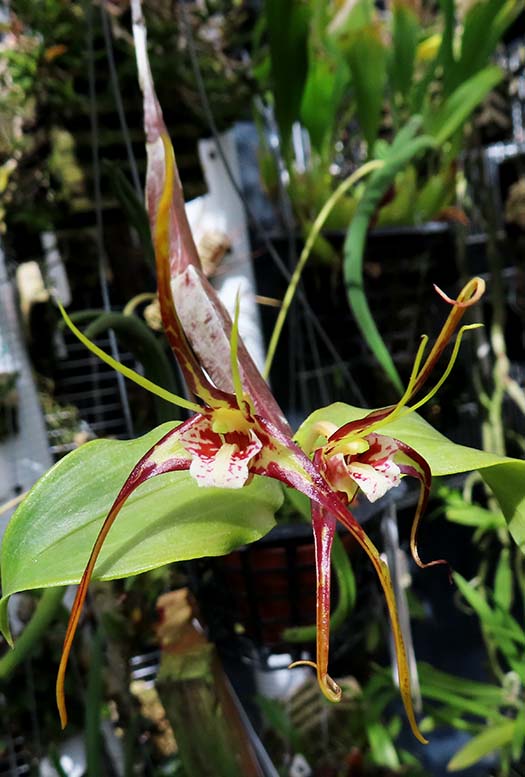 |
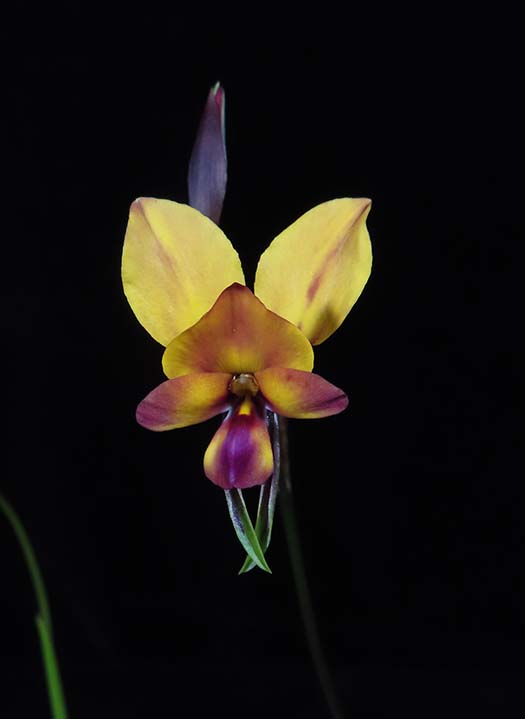 |
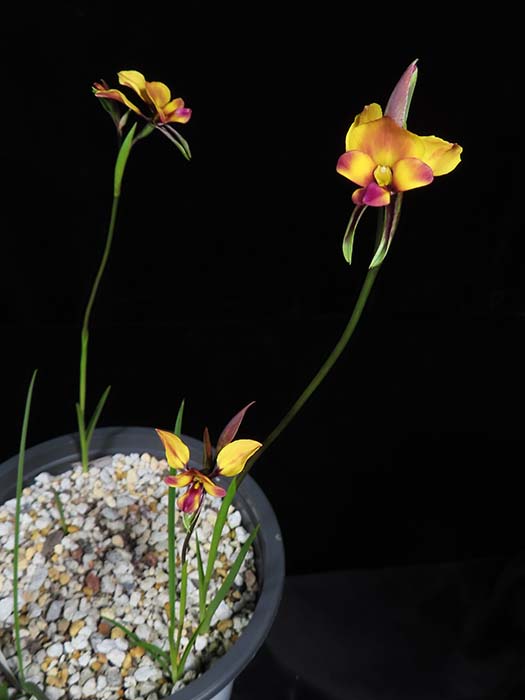 |
Diuris magnificaTerrestrial, native to western Australia. I think this is one of the most beautiful species in the genus, almost a rainbow. Like all of the Mediterranean-climate terrestrials, they'll spend the summer dormant and dry. |
|
Epidendrum difformeWeird yellow-green flowers with waxy substance, a prolific bloomer. Flowers are very long-lasting. |
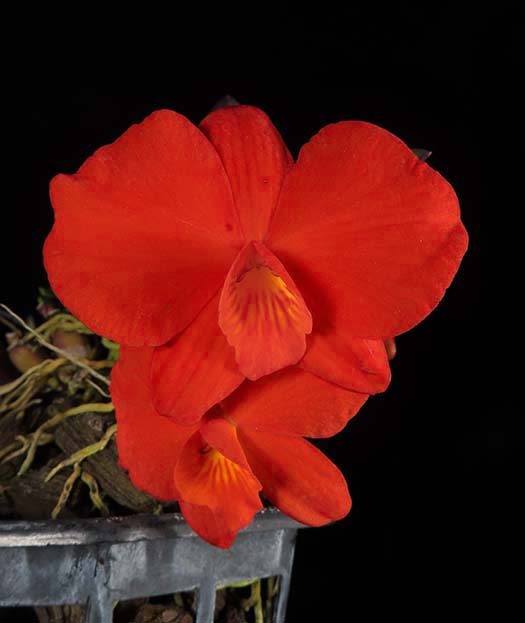
Cattleya (Sophronitis) coccinea 4nAs Scott pointed out last month, this is a challenge to photograph. I was able to capture the detail in the throat only by reducing the light somewhat. In bright light, the camera sees a red-orange blob. It is magnificent to look at in the sunshine, though. That extra set of chromosomes leads to big, round flowers. It's still the species, but I'm not sure that a pollinator would recognize it. |
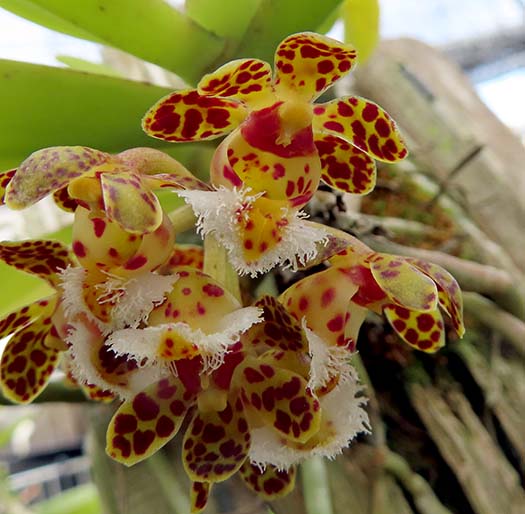
Gastrochilus calceolarisNative to a large region of the western Himalayas, south-central China, and southeast Asia, elevations 910-2300 m. In its habitat it can experience temperatures down to freezing. It started out on a mount but started to root into its surroundings so I placed it on an upside-down wood basket to give it more room. The flowers emerge from underneath the leaves, it's best to hang it fairly high so you can see them. |
 |
|
|
Lycaste lasioglossaFrom southern Mexico into Central America, cloud forest elevations around 1400-1800 m. It clearly loved the rain from the current winter and probably last winter as well, producing a nice flush bloom. |
|

Maxillaria tonsbergiiBig, waxy flowers with lovely sunset colors. They are also extremely fragrant. The plant tends to spread out. It is currently in a 10-inch bulb pan, to give it some room with much less bulk than it would have in a standard 10 inch pot. |
|
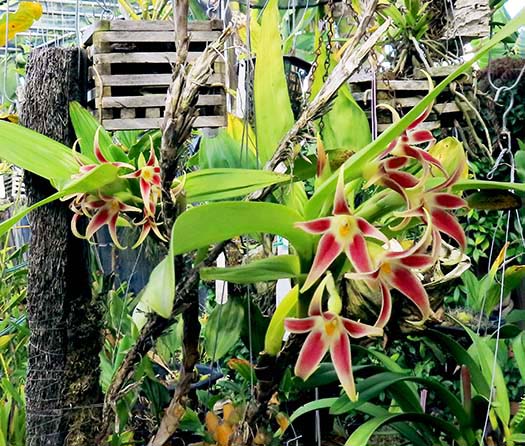
Maxillaria bradeorumThis is not a miniature, but since its growth habit is mostly vertical, it has a modest-sized footprint. It came to me established on a long chunk of hapu'u. The mystery is its root system - there does not seem to be much root growth on the mount, but the growths just get longer (ranging from 2 to 3 feet), there is just a bit of branching. I suspect that the root system is mostly contained under the dry sheaths that line the stems of the plant. As with other "climbing" Maxillarias, don't be tempted to "tidy up" those dry bracts - removing them will damage the roots and possibly kill the plant! Flowers emerge from the base of the new leaves. |
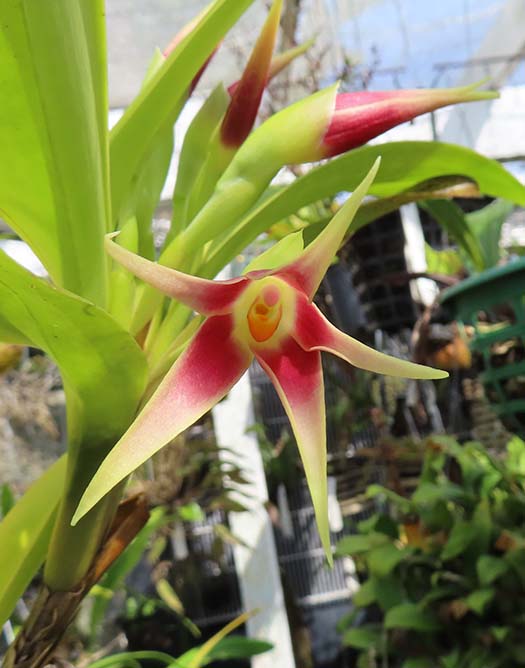 |
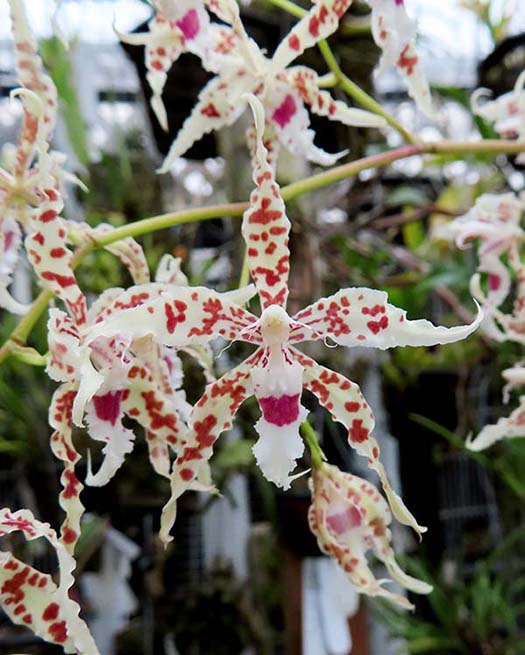
Odontoglossum lucianianumThis plant has an extensive backstory involving the efforts of a dedicated orchid conservationist seeking to bring this species into cultivation in the US by finding cultivated specimens in collections in South America, breeding them, and getting the resulting seed capsule propagated. I feel privileged to have one of the babies, which is growing well on my patio. |
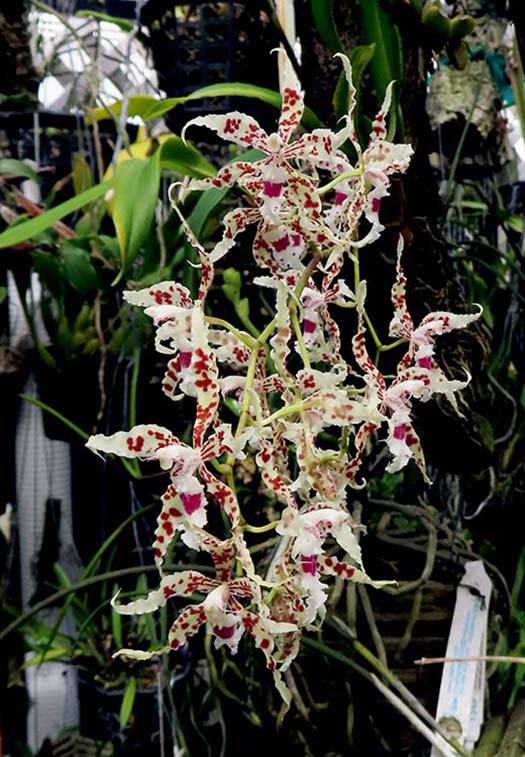 |
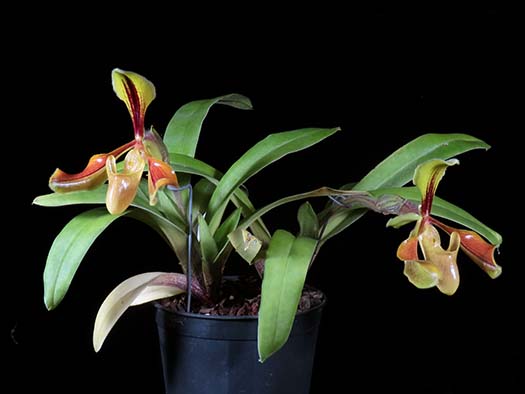
Paphiopedilum villosumThis, and related species such as Paph insigne, grow easily outside, and seem to like more light than most Paphs. |
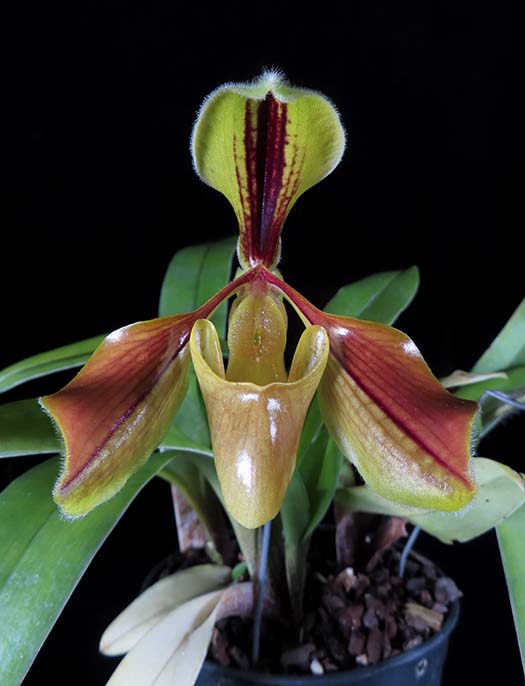 |
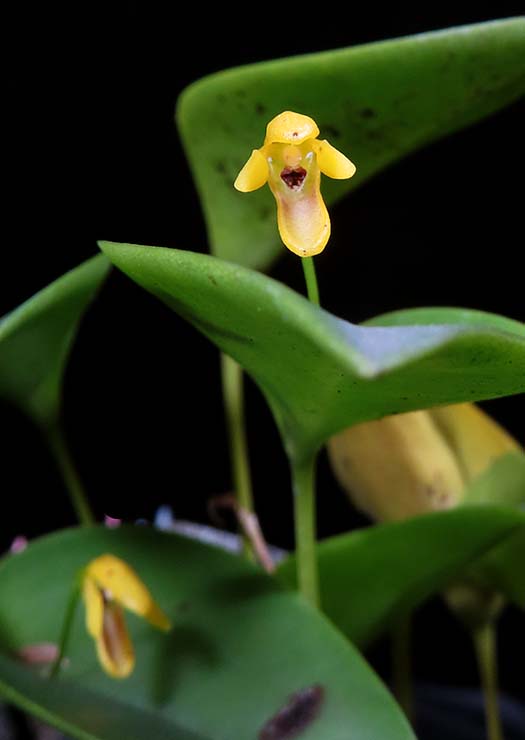
Pleurothallis recurvataNot dramatic, but the flowers are cute. |
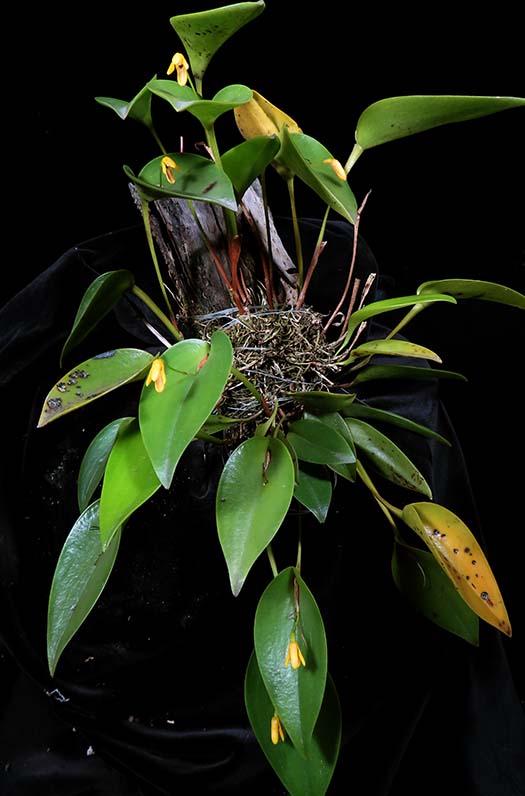 |

Rhyncholaelia glaucaThere is a lot of color variation within the species. Most are quite pale, but usually there is some pignent on the backs of the segments even if they look nearly alba from the front. The little red mark in the throat is another clue that that it has some red pigment, though that isn't always present. They can have considerably more pink in the segments, as on the right. They are fragrant, mostly after dark. |
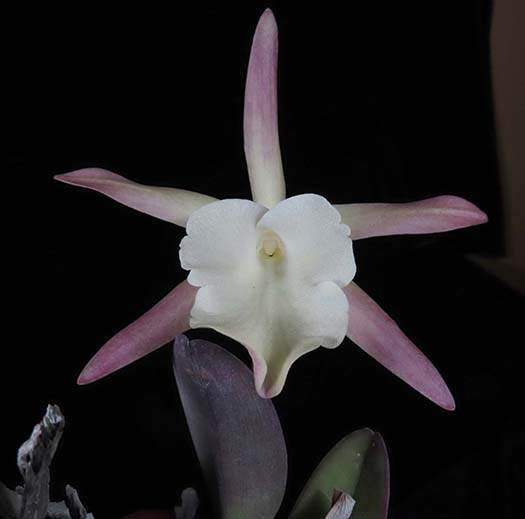 |
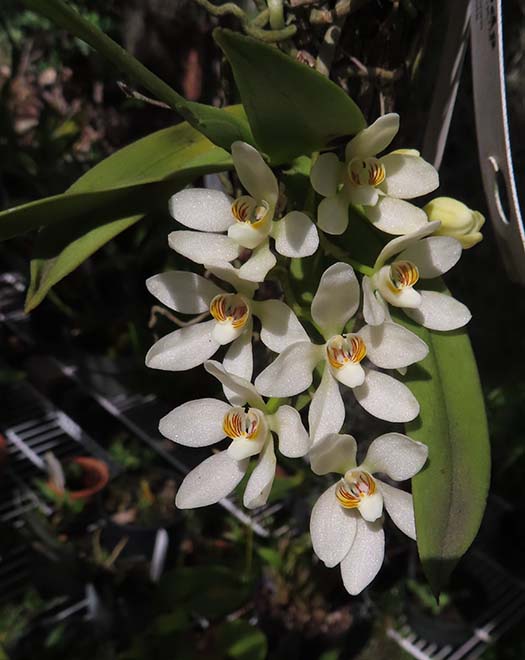
Sarcochilus falcatusAn Australian native. The flowers tend to be pendant, the plant grows well mounted. |
 |
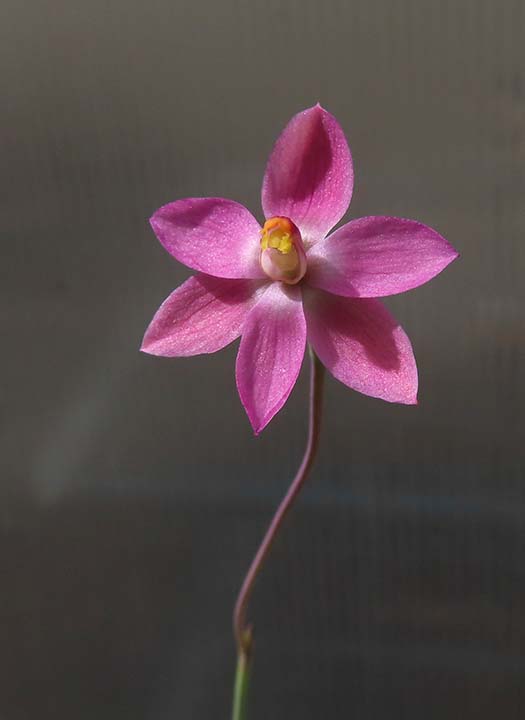 |
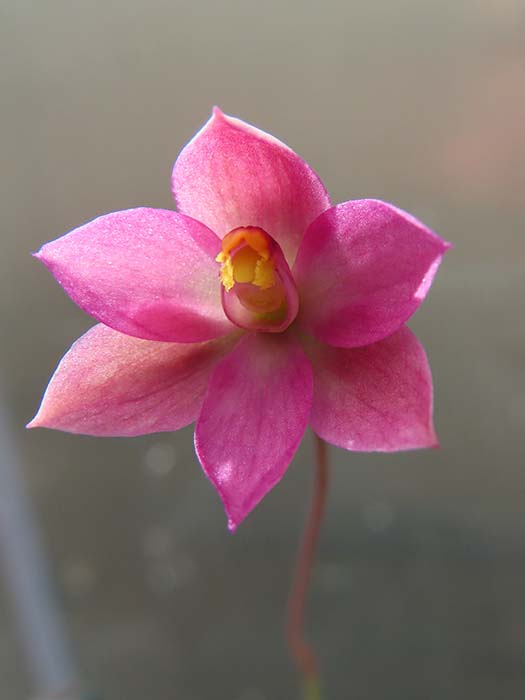 |
Thelymitra rubraThelys are not all blue! These Australian terrestrials are nicknamed "sun orchids" because they only open in bright sunshine. Even a little cloud cover, and they close up, waiting for the next sunny day. Found in eastern and southern Australia, and Tasmania. |
|
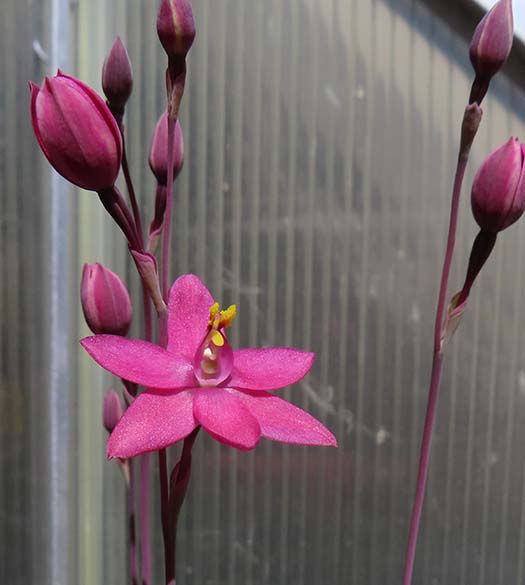
Thelymitra x macmillaniiThis is a natural hybrid (T. antennifera x T. nuda), found in south Australia to southwestern Victoria, Australia. |
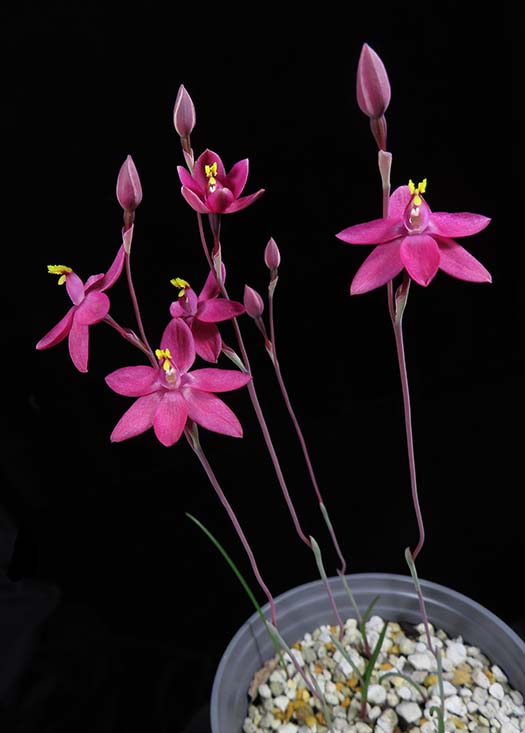 |
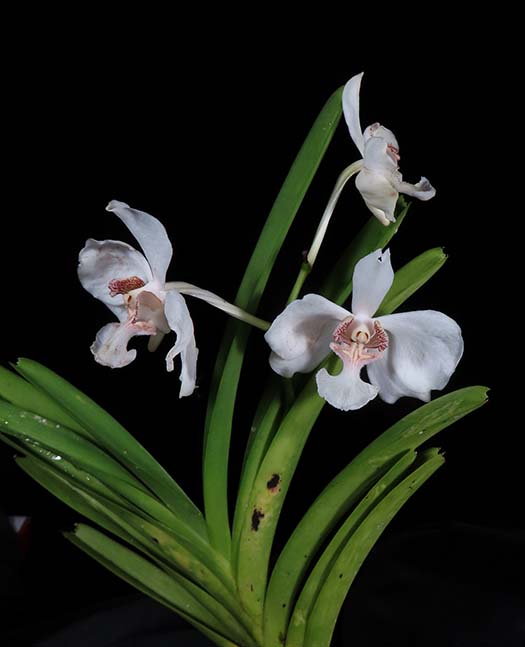
Vanda barnesiiImported as V. javierii, but turned out to be a new species. Both species are native to Luzon, Philippines, at elevation 1200-1600 m. |
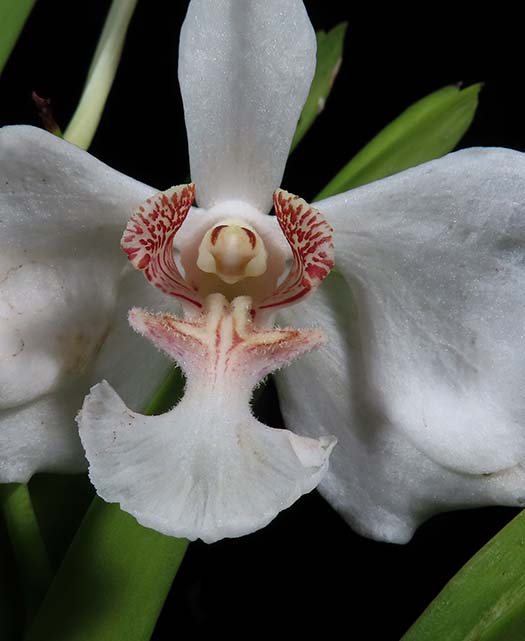 |
 |
|
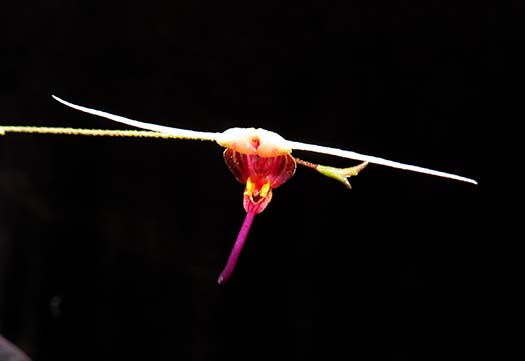 |
 |
Scaphosepalum merinoiFrom Ecuador. Like little birds. Sequential bloomer, don't cut spikes, they will be brittle and fall off on their own when spent. |
|
In the greenhouse... |
|
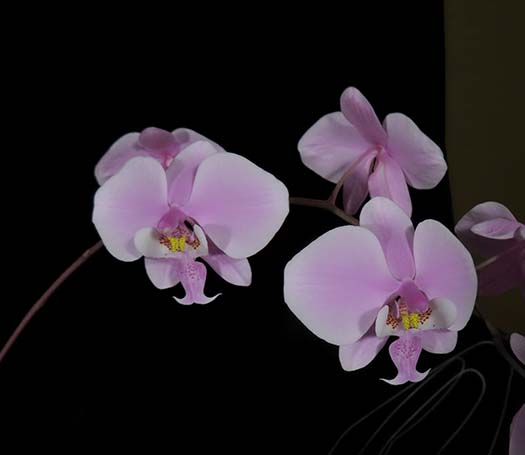 Phalaenopsis schillerianaThis plant is an over-achiever. Last year it produced two spikes, each of which produced leaves, then proceeded to continue with flower spikes. Months after the flowers faded, one of the leafy growths finally produced some roots, becoming a true keiki. That one I removed and potted separately (where it is now blooming). The other one only produced one small root so I left it attached to the old spike. This year it has flowered again. But the plant also produce a new, multi-branched spike that is about 30 inches long. This species is attractive even when not in bloom, with beautiful patterned leaves. |
|
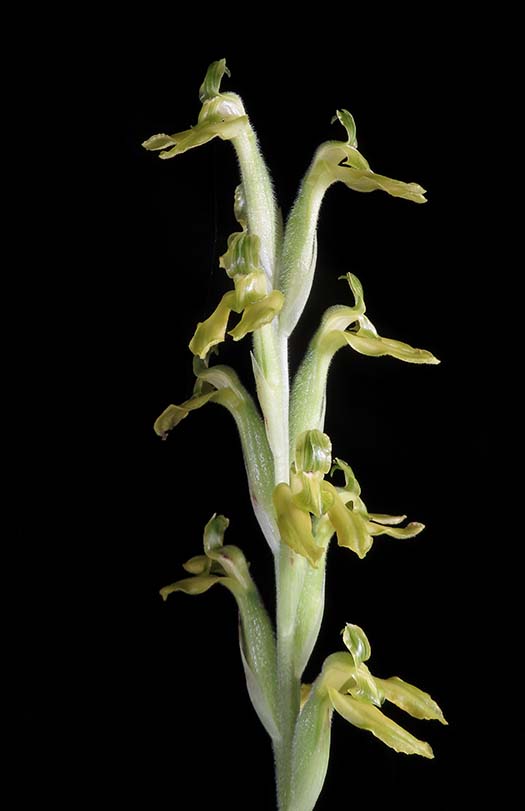 Sarcoglottis sceptrodesThis terrestrial has lovely patterned leaves (usually) that start to fade as the spikes emerge. This year, the leaves died back. leaving an empty pot, I feared that I had lost the plant. But a month or so later, three big spikes and one more litttle one did emerge. A new growth is just starting. These flowers are rather weird. They remind me of little dragons, or maybe sea horses in profile.
|
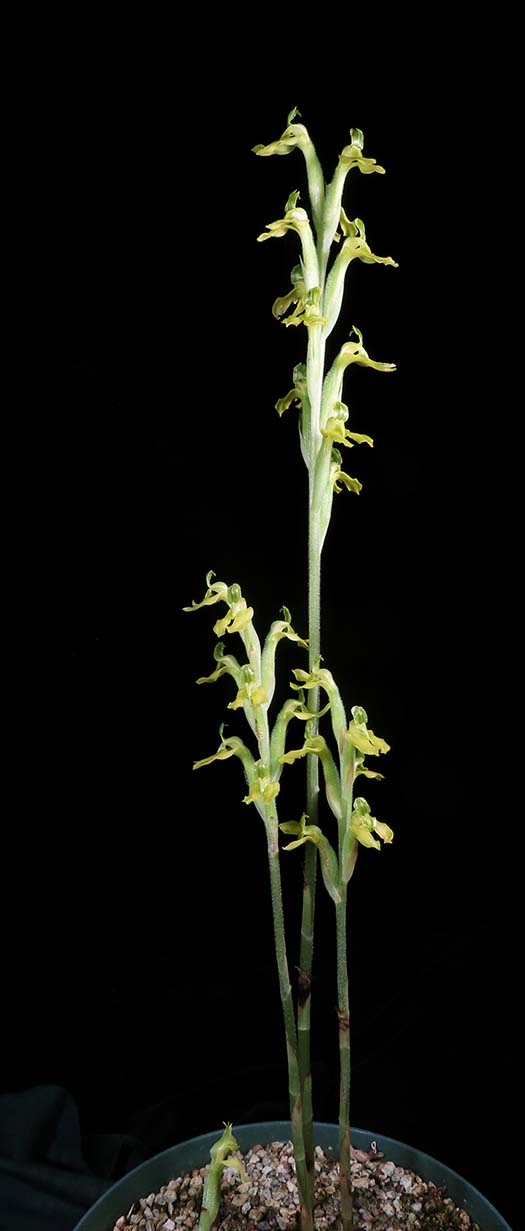 |
